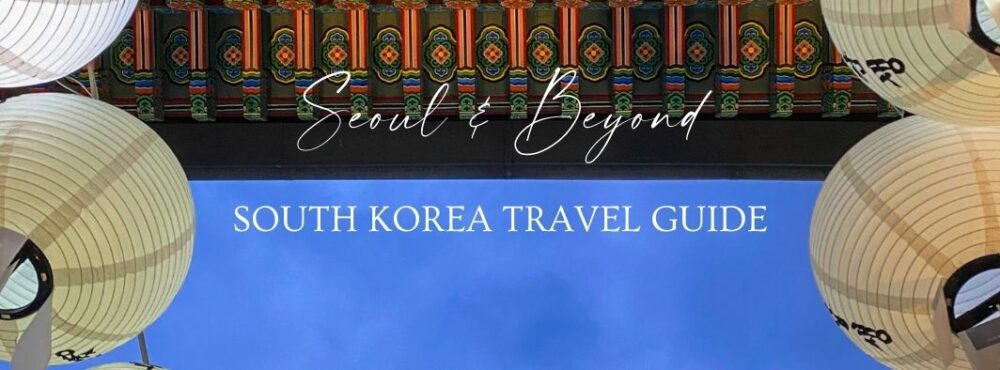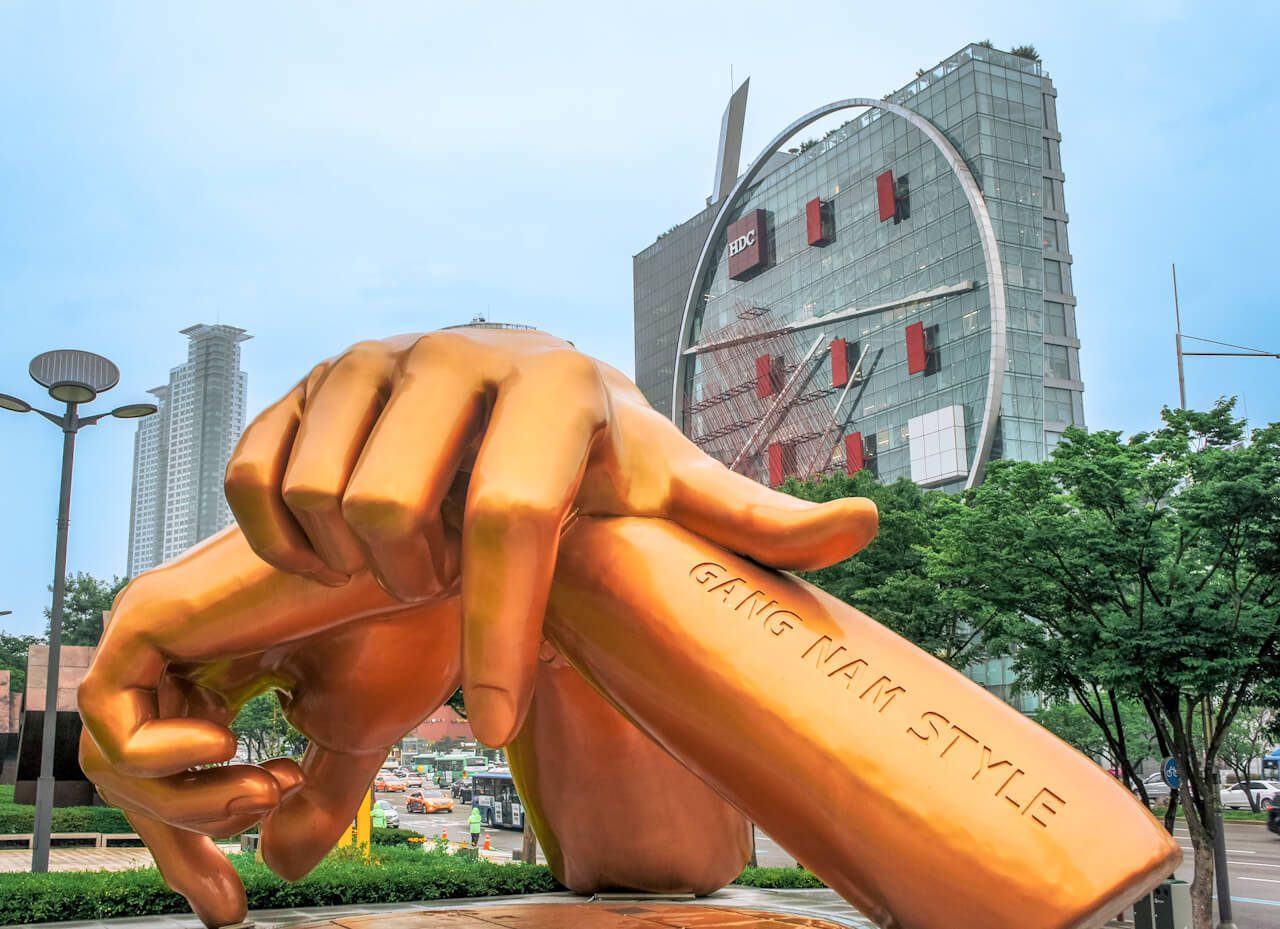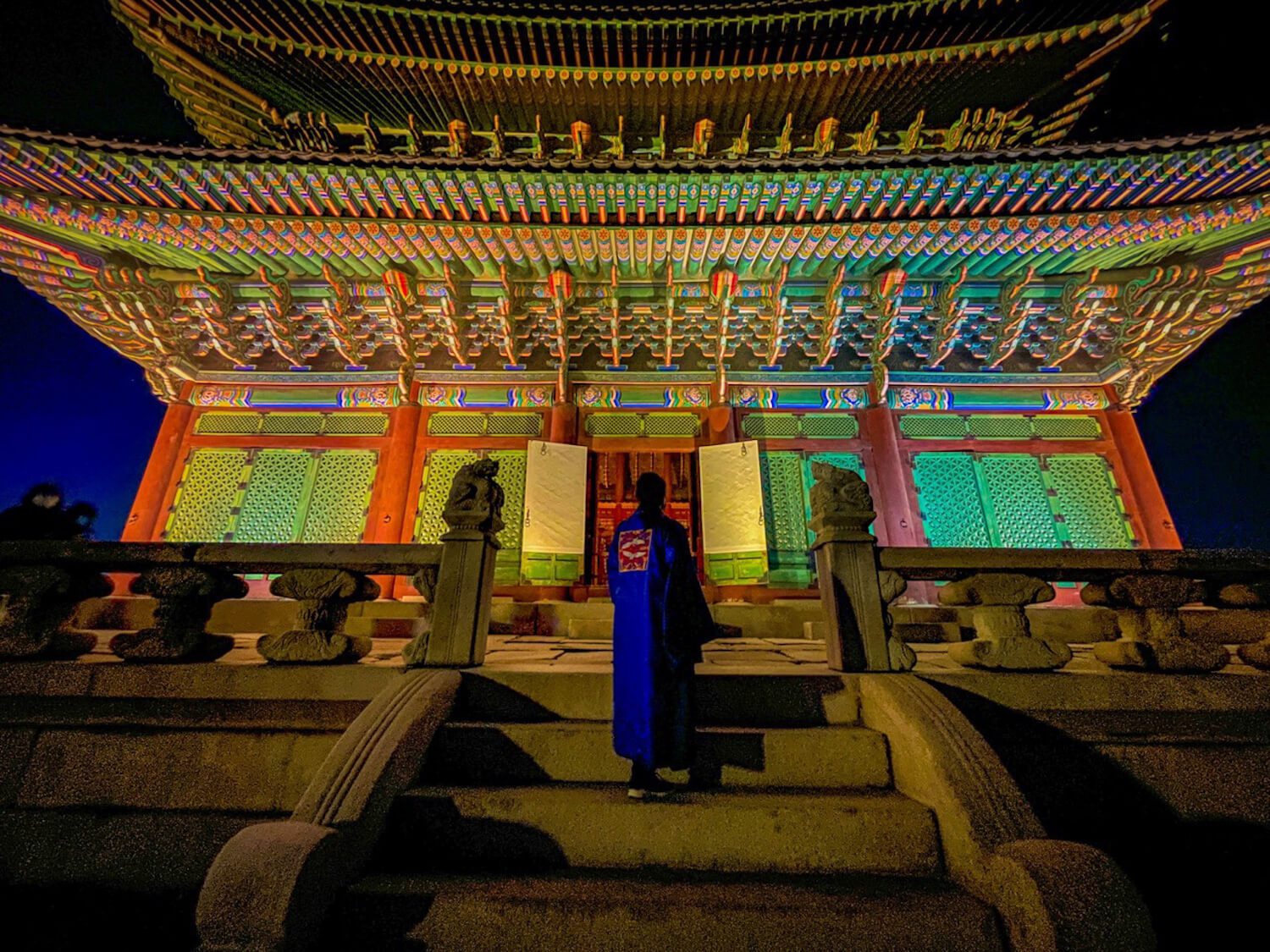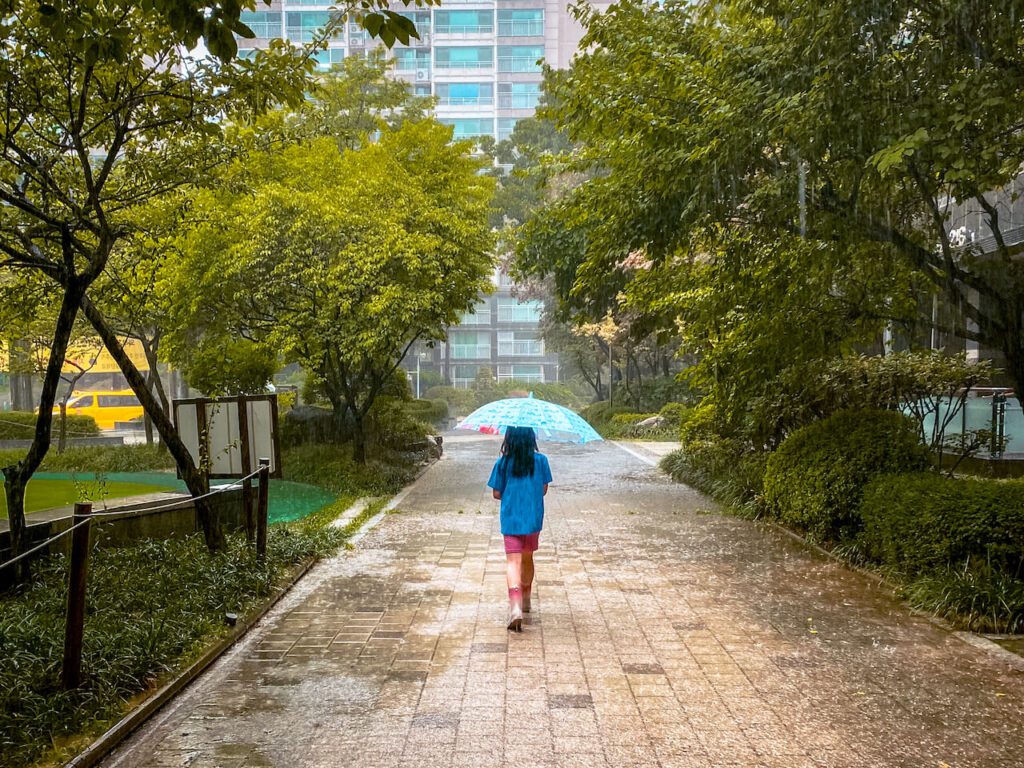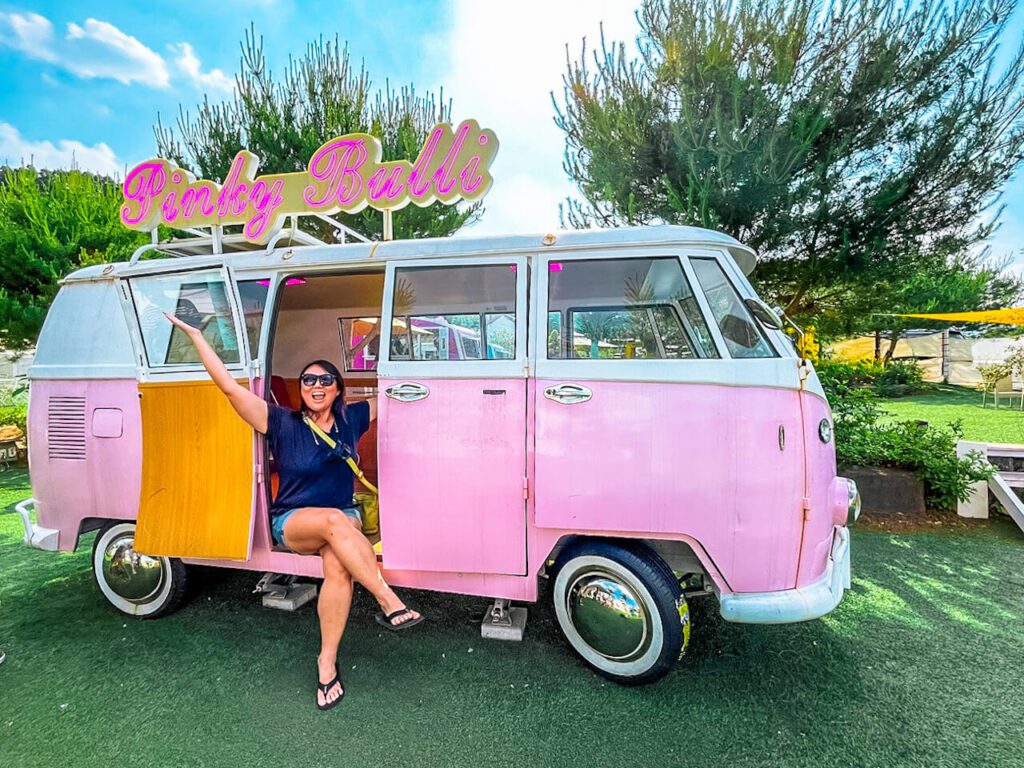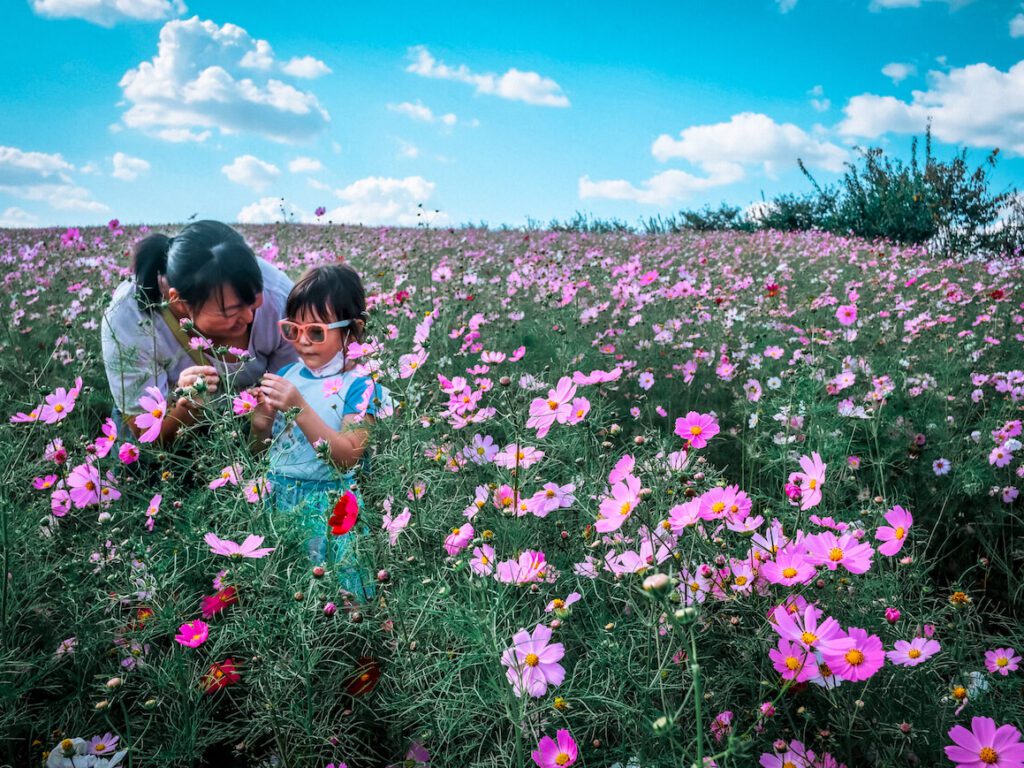How to Visit the Gwangyang Maehwa Festival 2025 | Korea’s First Spring Flowers!
As the darkness of winter succumbs to the lovely optimism of spring, maehwa flowers bloom across the warmer southern regions of Korea. Here in the ROK, it’s the first sign that the season of renewal is finally upon us.
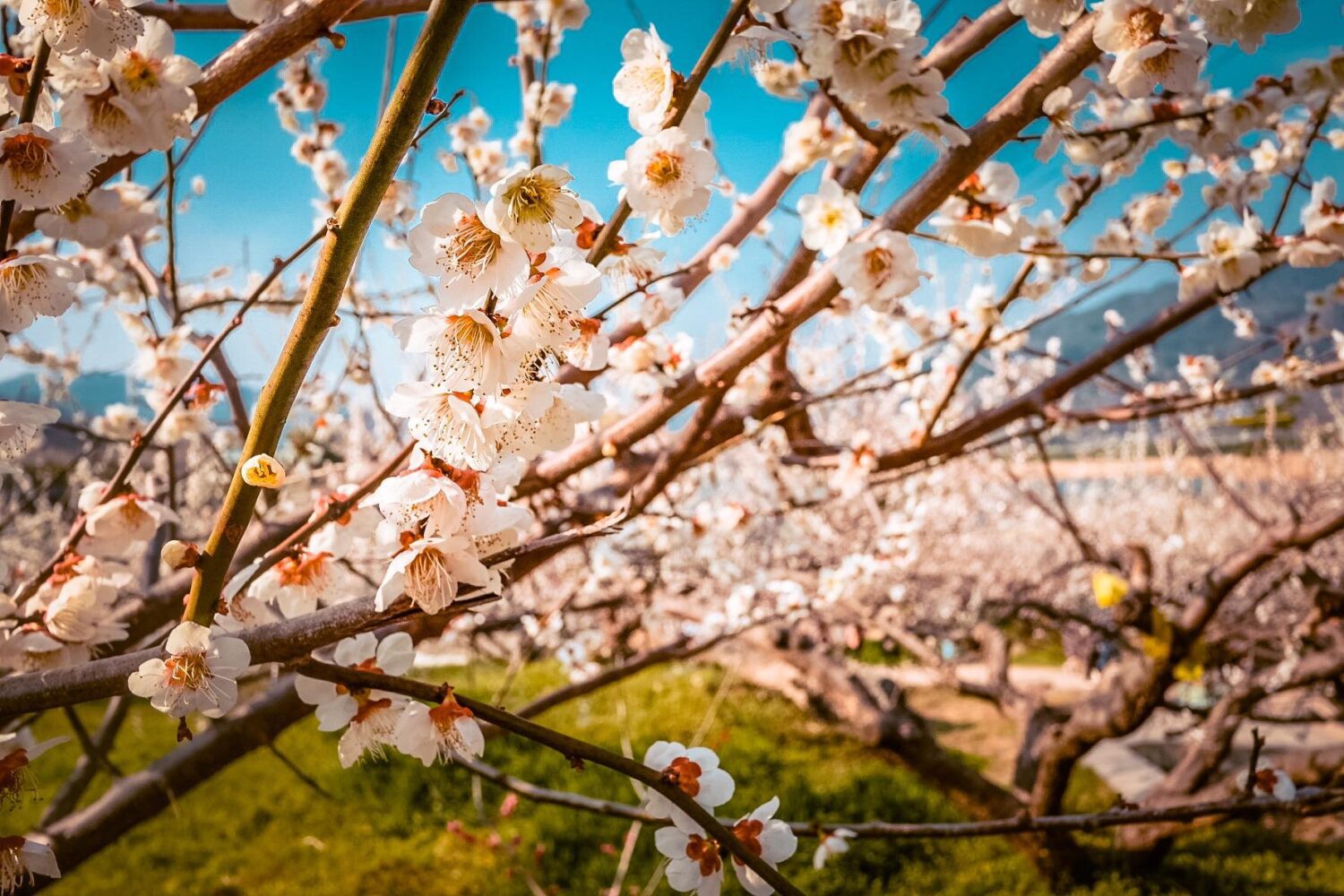
Maehwa signal the start of spring in Korea.
The Gwangyang Maehwa Festival is undoubtedly the best place in Korea to see these pretty flowers. It’s a trek and a half to get to the festival site from Seoul, but it’s SO worth the travel time.
Shake off that winter hibernation, and get down to Gwangyang Maehwa Village as fast as you can – because there are literally hundreds of thousands of gorgeous plum blossoms bursting into bloom.
*Any purchases made through affiliate links here help run this site.
In this guide
- 1 Gwangyang Maehwa Festival Quick Guide
- 2 What is Maehwa? | 매화
- 3 Planning a trip to Korea?
- 4 When is the Gwangyang Maehwa Festival?
- 5 HongSsangri (홍쌍리): The Mother of Plum Blossoms
- 6 How to Get to the Gwangyang Maehwa Festival
- 7 Limited Edition Spring Tours in Korea
- 8 Where to Stay in Gwangyang
- 9 What to Eat at the Gwangyang Maehwa Festival
Gwangyang Maehwa Festival Quick Guide
Plum Blossom Festival Dates | March 7th - 16th, 2025 |
Address in English | 1563-1 Seomjingangmaehwa-ro, Gwangyang-si, Jeollanam-do |
Address in Korean | 전라남도 광양시 다압면 섬진강매화로 1563-1 |
Operating hours | Gwangyang Maehwa Village is open 24/7 |
What to Eat and Drink | Maesil ice cream, maesil magkeolli, maesil bibimbap, Gwangyang bulgogoi |
Transport Options | Rent a car, DIY by bus (5.5+ hours), or join a tour |
Recommended Way to Go |
What is Maehwa? | 매화
First things first. What the heck are maehwa anyway?
Maehwa (매화) is the Korean word for a particular type of plum blossom that’s been cultivated in East Asia for the last 1,500 years – the prunus mume.
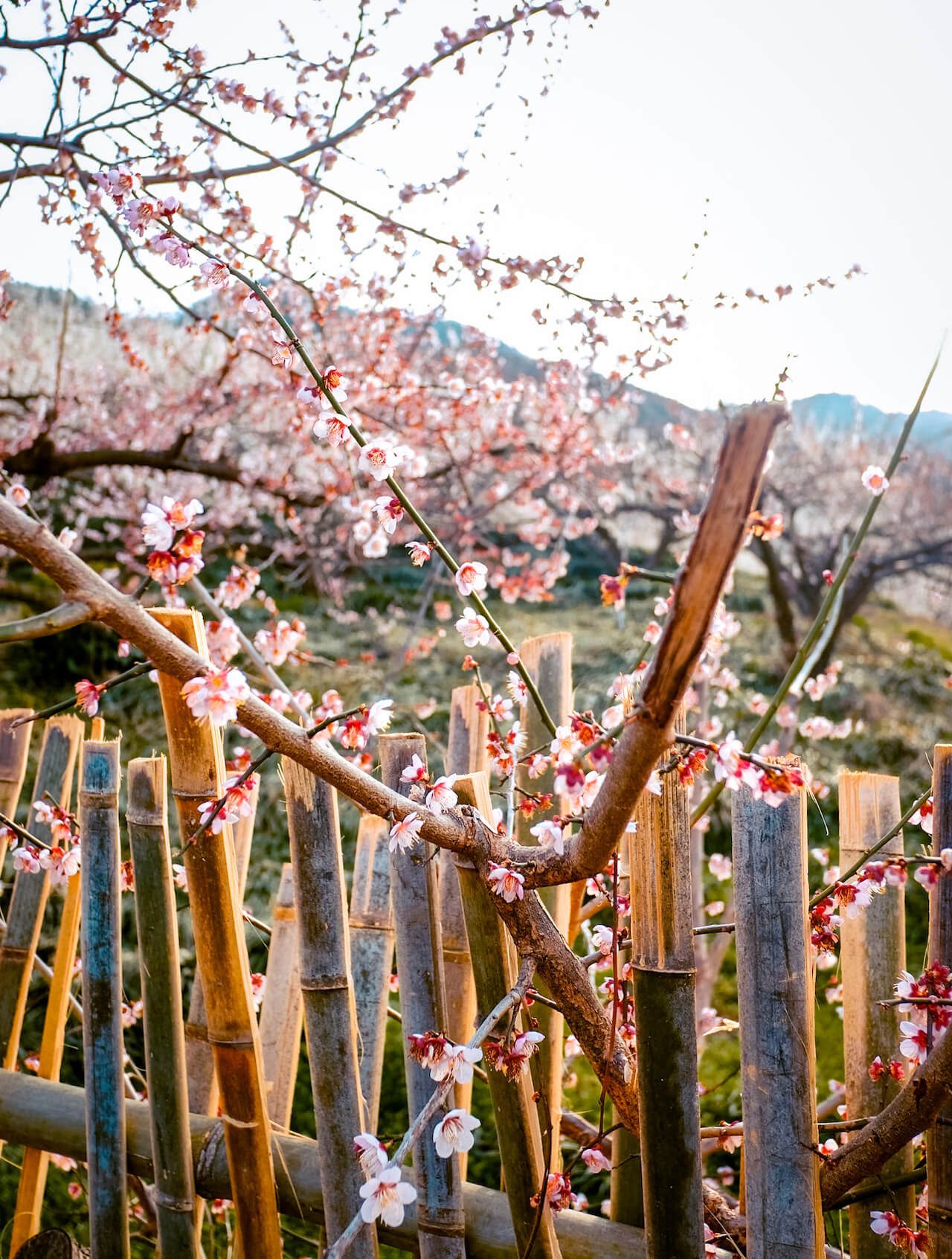
Plum blossoms are the first sign of spring in Korea.
Blooming in late winter on Jeju Island, and in early March in Jeollanam-do Province, maehwa flowers signal the coming of spring in Korea.
There are several different colours of maehwa flowers. Pale pink and white plum blossoms (baekmae), are fairly common, but you’ll also see striking red hongmae and greenish cheongmae blossoms too.
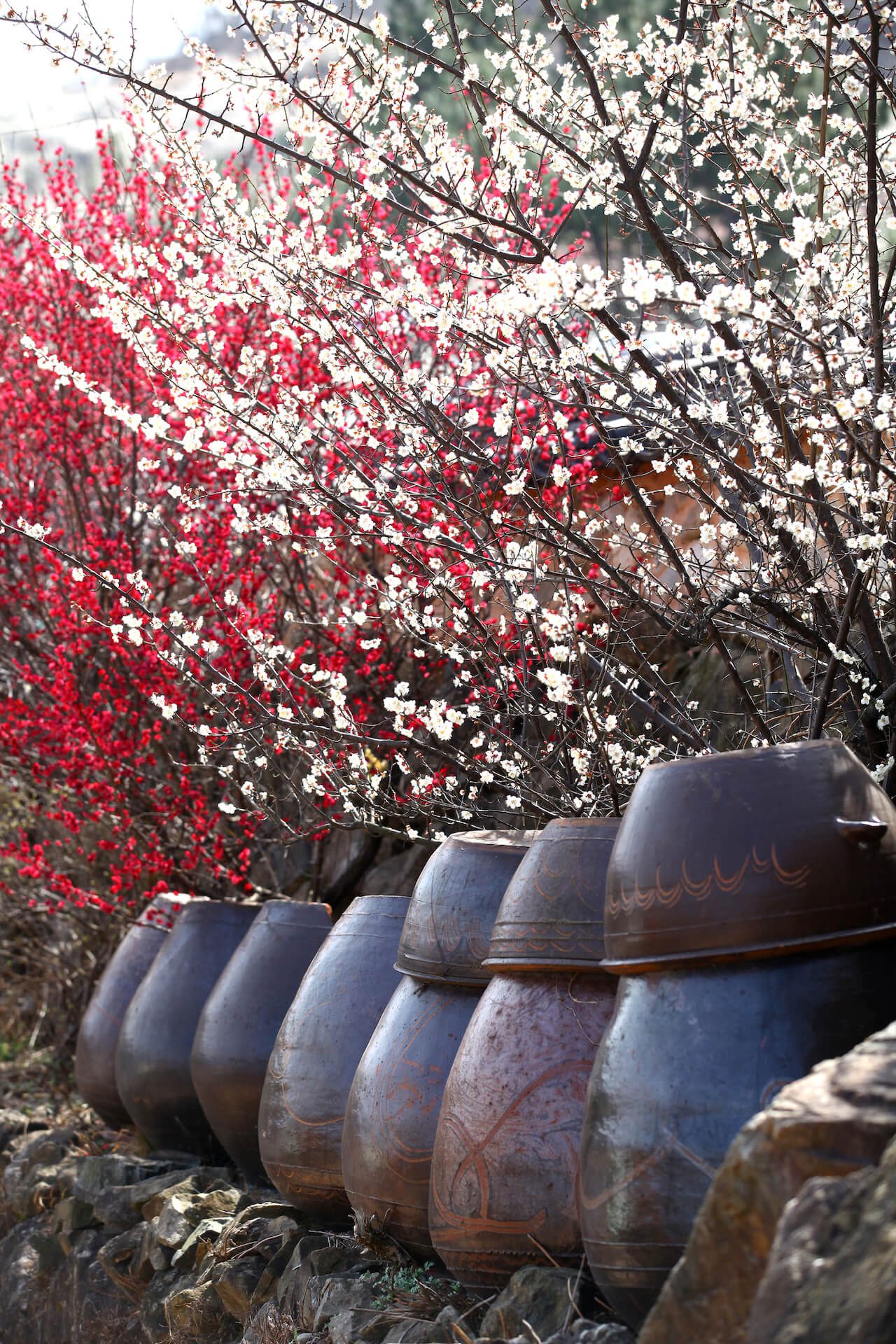
Maehwa bloom in a variety of pretty colours © Lee Beomsu, Korea Tourism Organization
Maehwa was considered one of the 4 gracious flowers by Joseon Dynasty scholars (along with orchid, chrysanthemum, and bamboo) – symbolizing the noble mind, and the virtue of patience. Thus, plum blossoms are a common theme in traditional Korean literature and art.
Maesil (매실) is the fruit of the maehwa tree. This green plum ripens in late May and early June, and its juice is then used in a huge number of products, including alcohol, skincare products, foods, and traditional medicine.
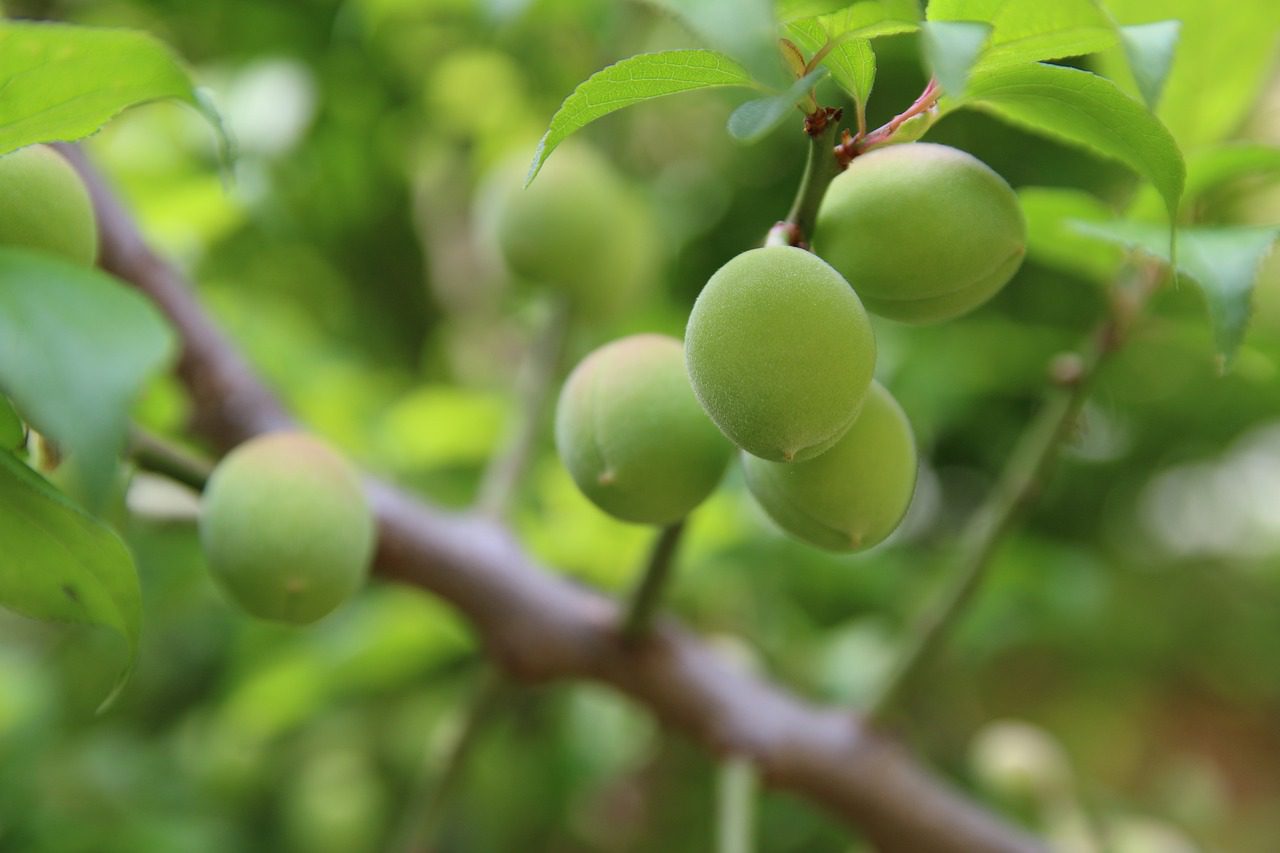
Maehwa trees eventually produce maesil or green plums.
If you want to enjoy these fragrant blooms yourself, the Gwangyang Maehwa Festival, Hwaeomsa Temple, Jeju Hueree Natural Park, and Changdeokgung Palace are among the most wonderful places to see maehwa in Korea.
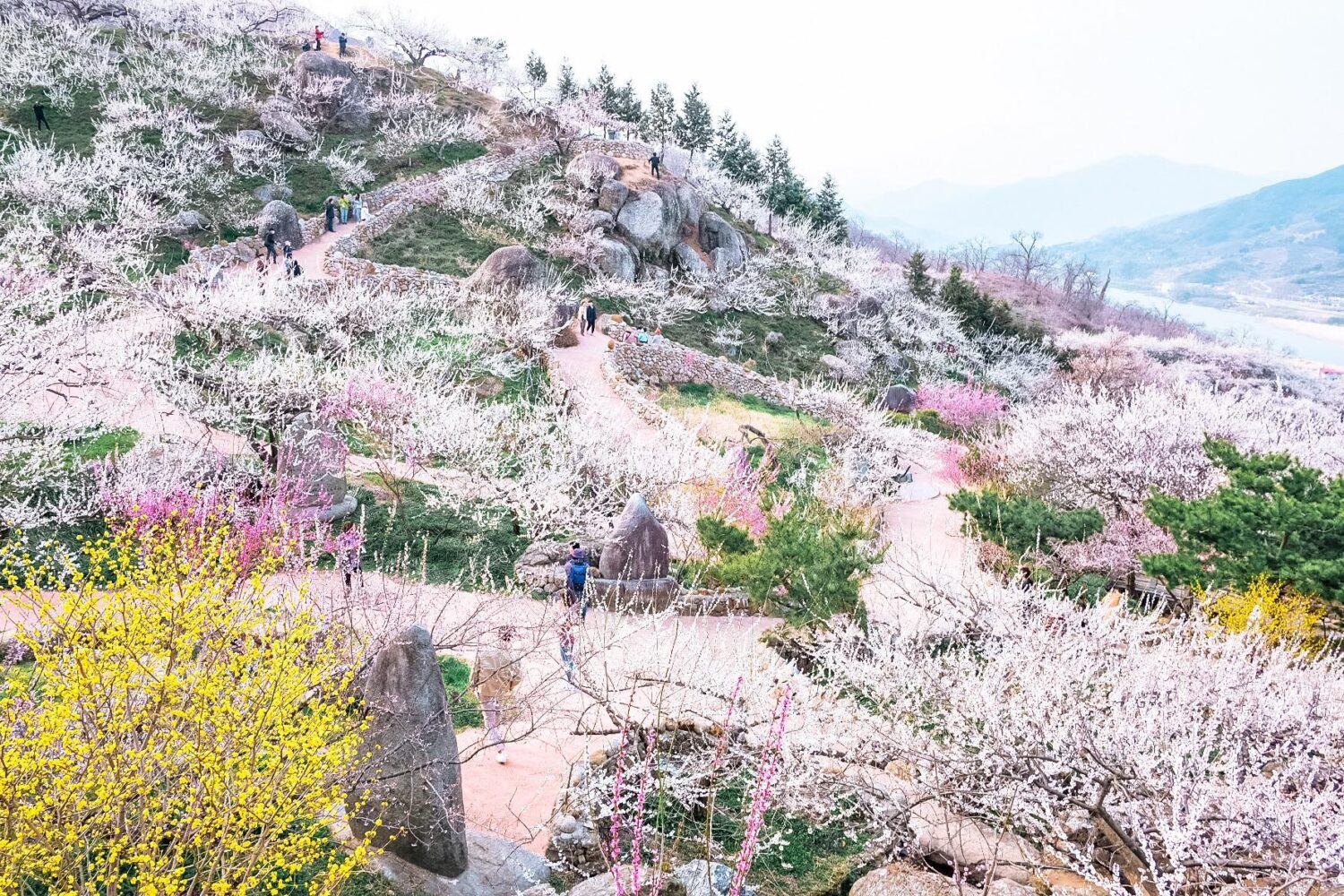
Gwangyang Maehwa Festival has all the spring vibes.
Planning a trip to Korea?
Connect with other travellers | Ask and get answers to all your travel questions | Learn about all the best things to do in Korea | Join my Seoul and Beyond, South Korea Travel Planning Group on Facebook now.
South Korea Travel Essentials
Hotels and Other Accommodation
Tours, Admission Tickets, and Things to Do
Klook | Trazy | Get Your Guide | Fever |. Creatrip
Airport Transfers, Transit, and Transportation
Discounted AREX Incheon Airport Express Train
K Airport Limousine Bus from Incheon Airport
Private Airport Transfers from Incheon or Gimhae
Car Rentals (International Drivers Permit required)
Seoul to Busan KTX high speed rail tickets
Korean Express and Intercity Bus Reservations
Wifi, SIM Cards, and Portable Wifi
Airalo eSIM | unlimited data SIM cards | Portable and Pocket wifi
Money-Saving City Passes
Visit Busan Pass with FREE admission to 31 attractions + 77 discounted
Wowpass, Prepaid Debit Card for Cashless Payment in Korea (includes T-money Card)
Apricot / Plum Blossoms vs Cherry Blossoms
There are a lot of pinkish flowers that look similar and bloom around the same time in Korea, so it can be pretty confusing if you don’t know what to look out for. I’ll try to clarify.

Pink flowers blooming in early March are NOT cherry blossoms – they’re maehwa!
In East Asia, apricot and plum blossoms are different names for the exact same Chinese tree species – the prunus mume.
Apricot / plum blossoms come in a variety of colours, ranging from white to pink to red, and bloom at least a few weeks earlier than cherry blossoms. If you’re visiting Korea in early March, the flowers you’re seeing on trees are likely maehwa – NOT cherry blossoms.
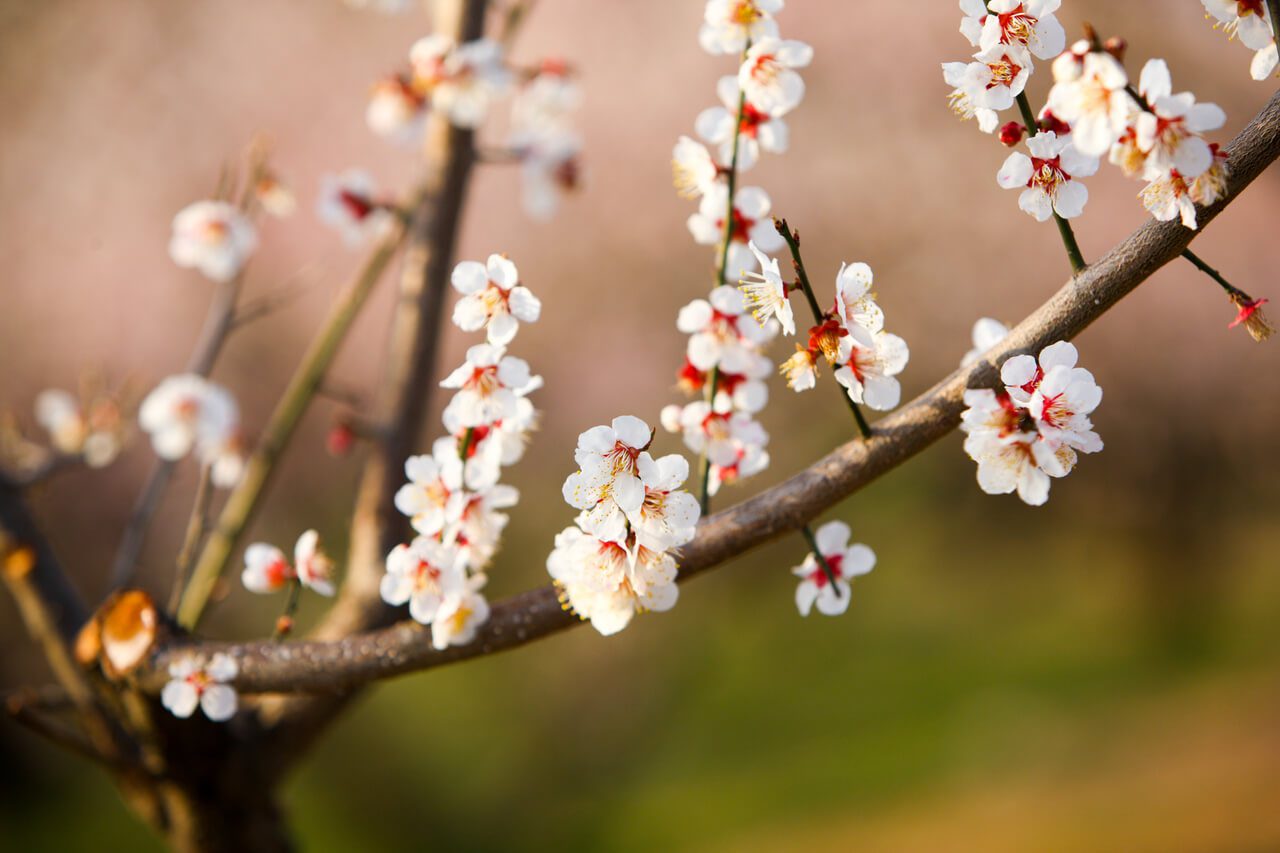
Maehwa are uniformly round on each petal © KTO Kim Jiho, Korea Tourism Organization
One surefire way to tell the difference, is to look closely at each petal. Cherry blossoms have a small notch at the end, whereas apricot / plum blossoms don’t.
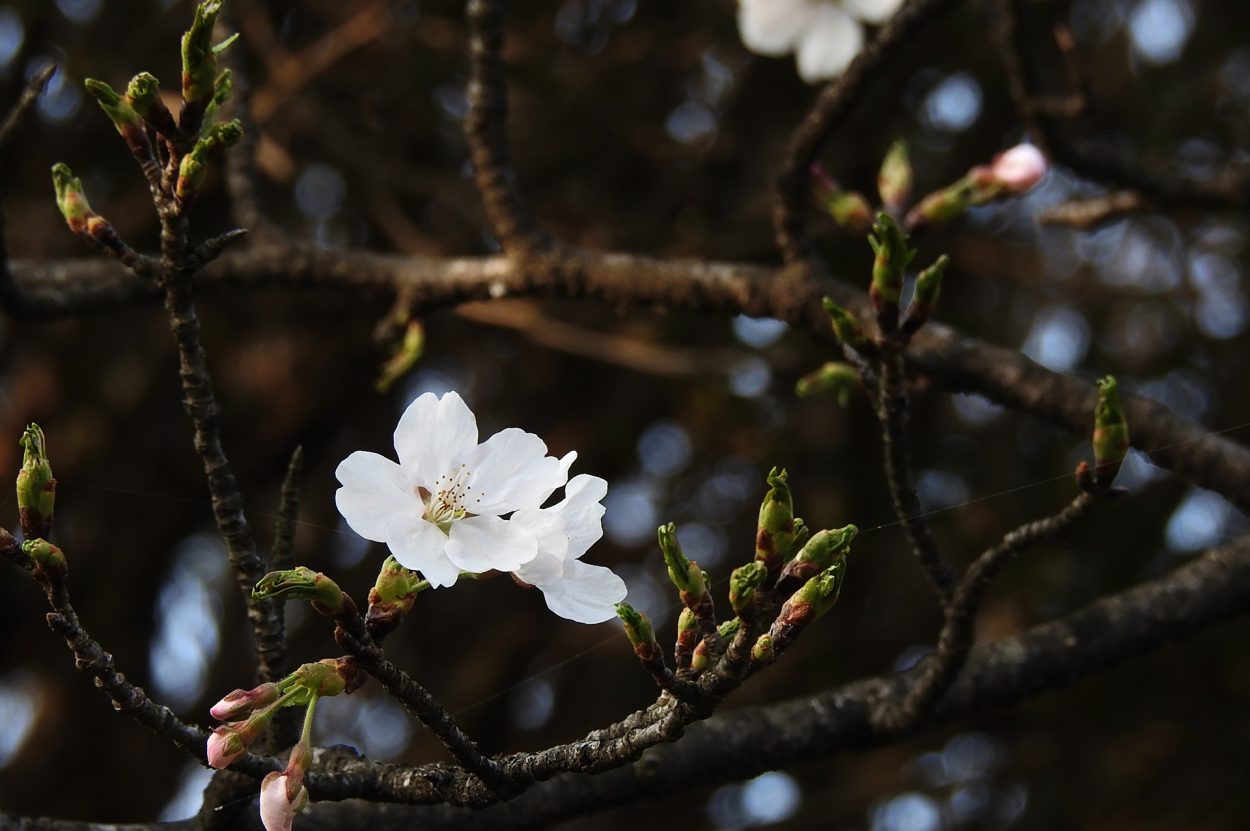
Cherry blossoms have a small notch on the end of each petal.
When is the Gwangyang Maehwa Festival?
Festival Dates: March 7th – 16th, 2025
Brilliant sansuyu and pretty plum blossoms are some of the earliest flowers to bloom in South Korea in spring, and the Gwangyang Maehwa Festival is one of the very first flower festivals to take place on the Peninsula.
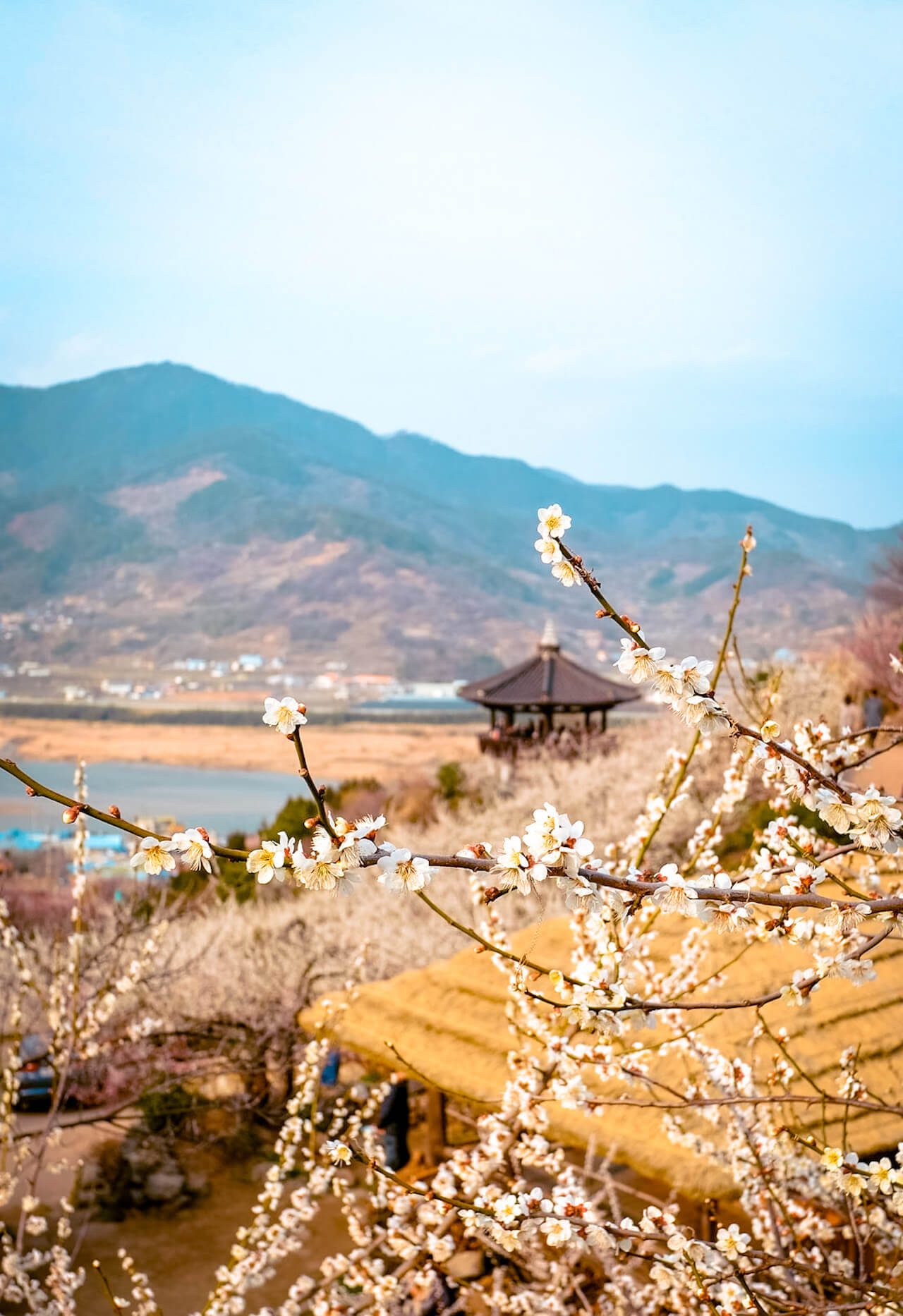
Pretty plum blossoms at the Gwangyang Maehwa Festival.
This year, the festival is scheduled from March 7th to 16th, but I’m sure you could visit after these dates and still see pretty plum blossoms. It takes place at Maehwa Village in Gwangyang, which is located next to the picturesque Seomjingang River. You can just imagine how gorgeous the views are there!
The village has a staggering 10,000 maehwa trees scattered across 200,000 square metres of land, but, believe it or not – it still gets crowded during peak bloom. If you’d like to find peace among the plum blossoms, visit on a weekday, as early in the morning as possible.
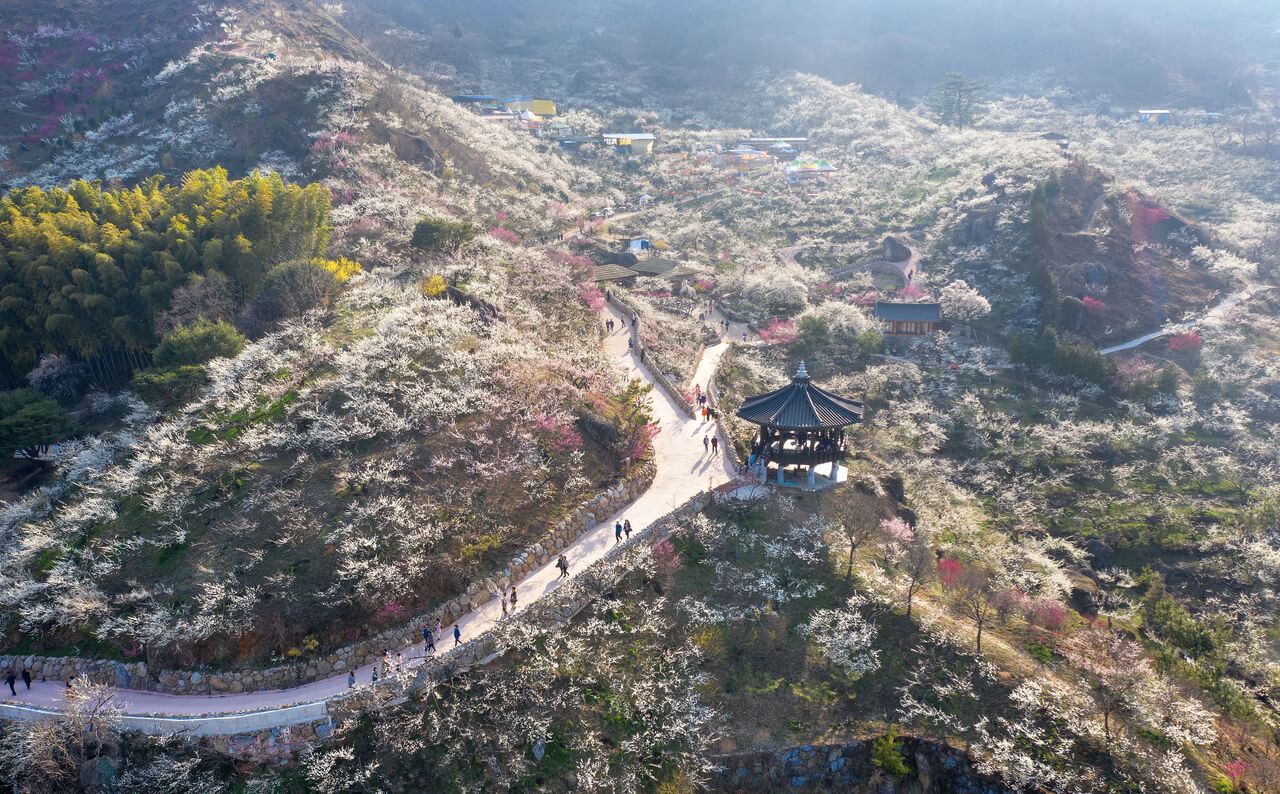
There are hundreds of thousands of plum blossoms at Maehwa Village © Kim Jin-hwa, Korea Tourism Organization
EARLY SPRING DAY TOURS | The Sansuyu Festival in Gurye and the Maehwa Festival in Gwangyang are Korea’s earliest spring flower festivals. I highly recommended a day tour for these though, since both are located in very rural areas, where public transit is challenging. Check full details here.
HongSsangri (홍쌍리): The Mother of Plum Blossoms
Before there was a Gwangyang Maehwa Festival, there was only HongSsangri – a humble farmer and housewife.
Born in Miryang in 1943, she moved to Gwangyang in 1965 after marriage. There, she toiled, struggling with financial difficulties, and her husband’s health issues for 30 years.
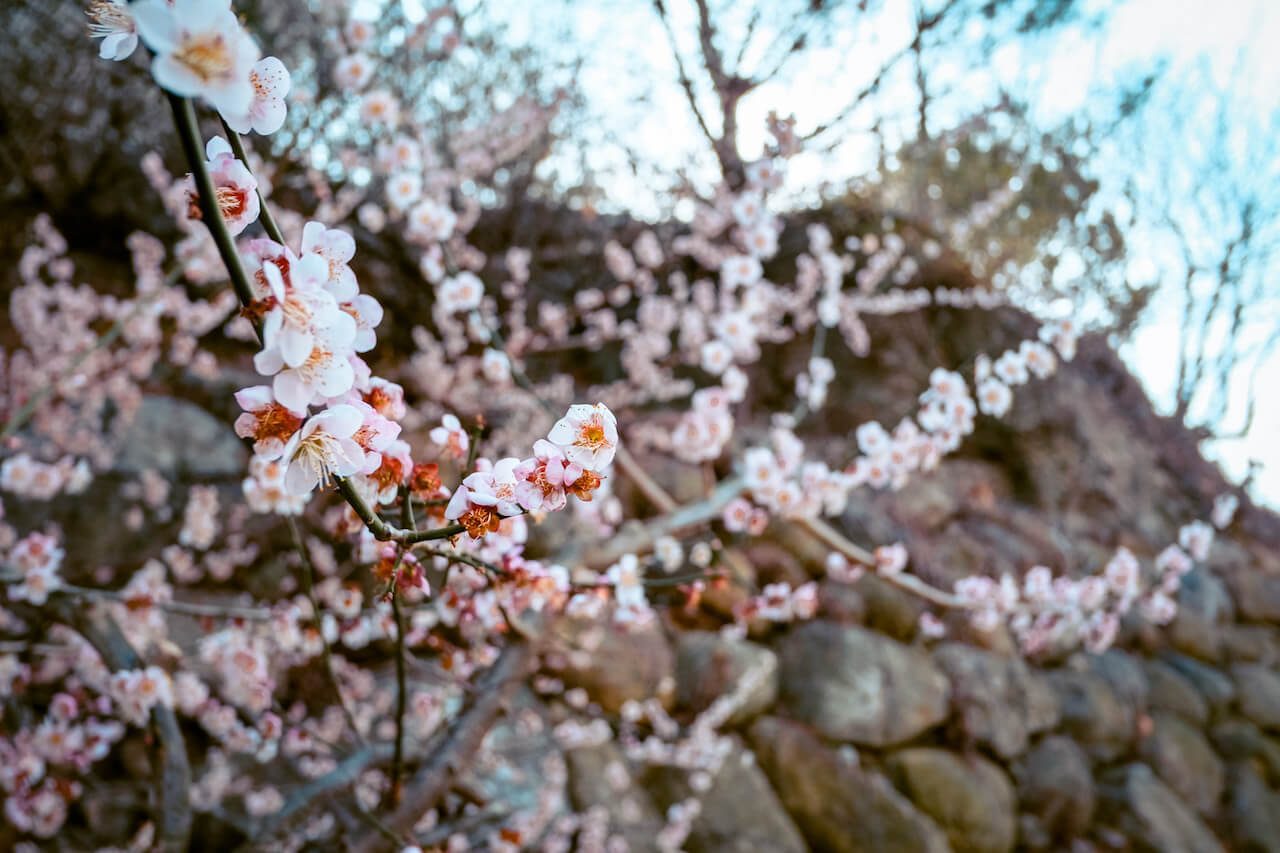
Plum blossoms at Gwangyang Maehwa Village.
Her life certainly wasn’t easy, but she didn’t let that stop her. Armed with nothing more than an elementary school education, incredible strength, indomitable will, and hard work, HongSsangri devoted herself wholly to plum farming.
She established the Cheongmaesil Farm (청매실농원) in 1994, and became a Plum Master in 1997.
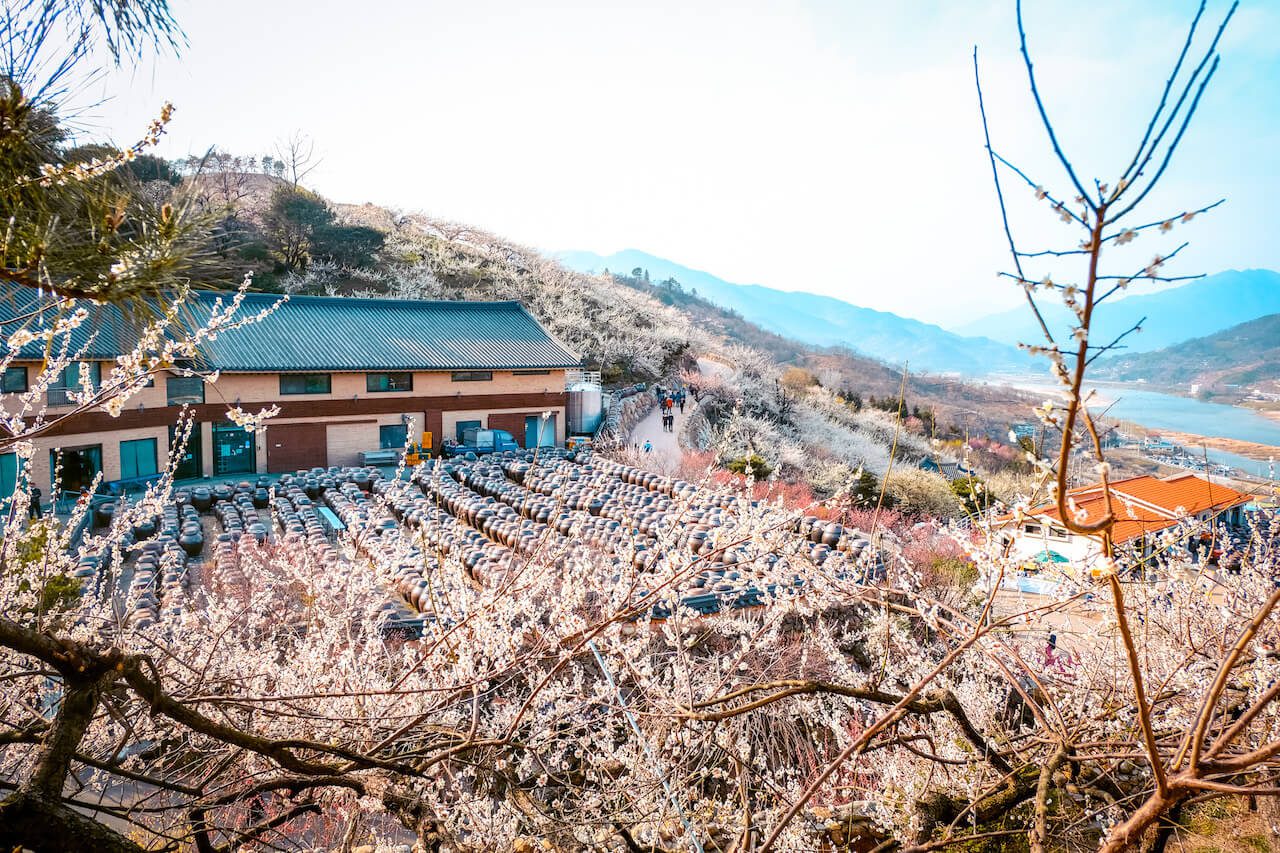
HongSsangri’s Cheongmaesil Farm kickstarted a $4m a year local maesil industry in Gwangyang.
Today, there’s 10,000 gorgeous plum blossom trees spread across 20,000 acres of land, a complete line of green plum products, a local maehwa industry that produces $4 million in revenue every year, AND one of the most popular early spring flower festivals in South Korea – the Gwangyang Maehwa Festival.
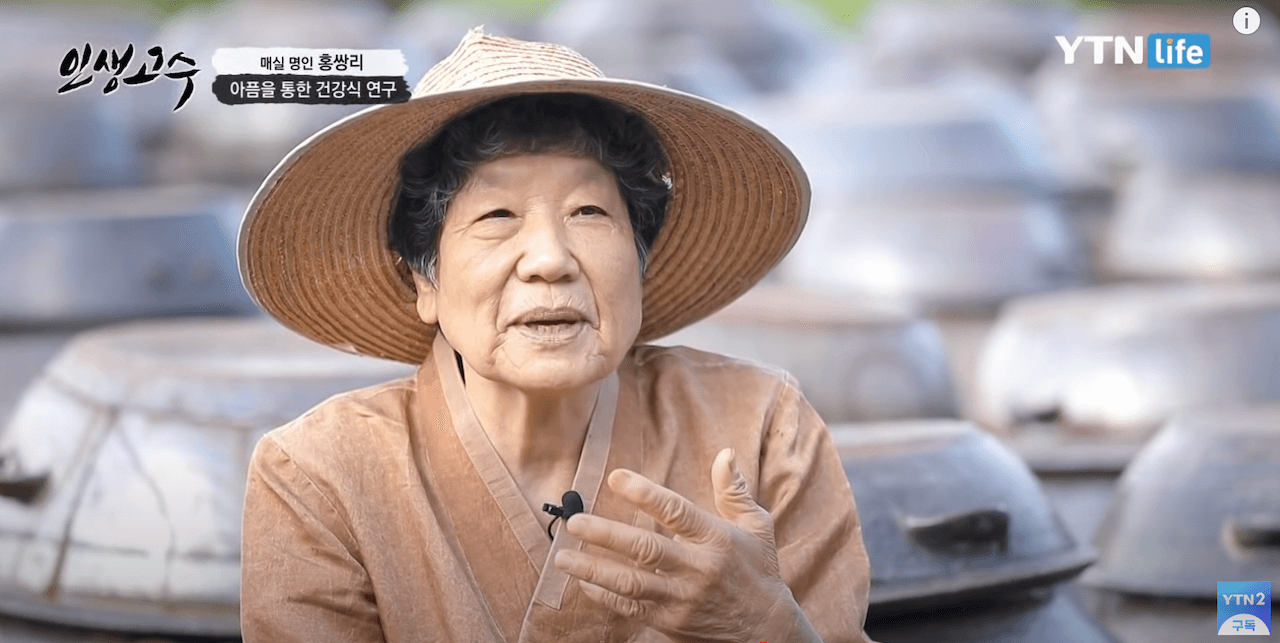
HongSsangri – the Mother of Plum Blossoms © YTN2
HongSsangri truly is Korea’s Mother of Plum Blossoms. If you’d like to learn more about this remarkable woman, check out this video (Korean only).
How to Get to the Gwangyang Maehwa Festival
Address: 1563-1 Seomjingangmaehwa-ro, Gwangyang-si, Jeollanam-do | 전라남도 광양시 다압면 섬진강매화로 1563-1
While it IS possible to DIY it down to Gwangyang, this is one festival in Korea that I absolutely recommend joining a tour that has transport included.
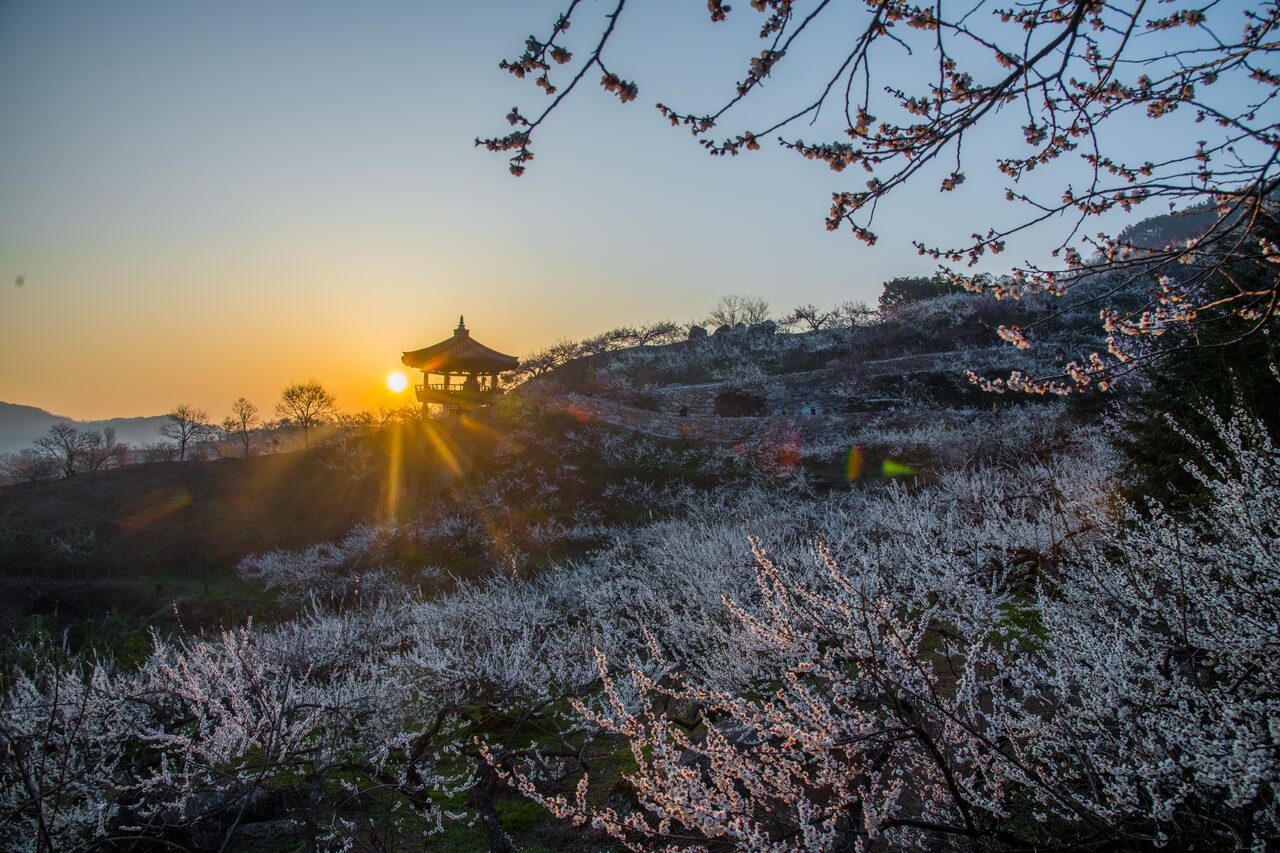
Gwangyang Maehwa Village is challenging to get to, and best visited on a day tour © Live Studio, Korea Tourism Organization
The festival is located in a super rural area that’s difficult to get to, and you’ll likely spend way more money on taxi fares (out of pure frustration from waiting for buses that never come) than you would on a tour.
Fortunately, there’s a few good ones, departing from either Seoul or Busan. Tours from Seoul usually also make a stop at Jeonju Hanok Village, which is totally worth a visit as well, for gorgeous hanoks and delicious food.
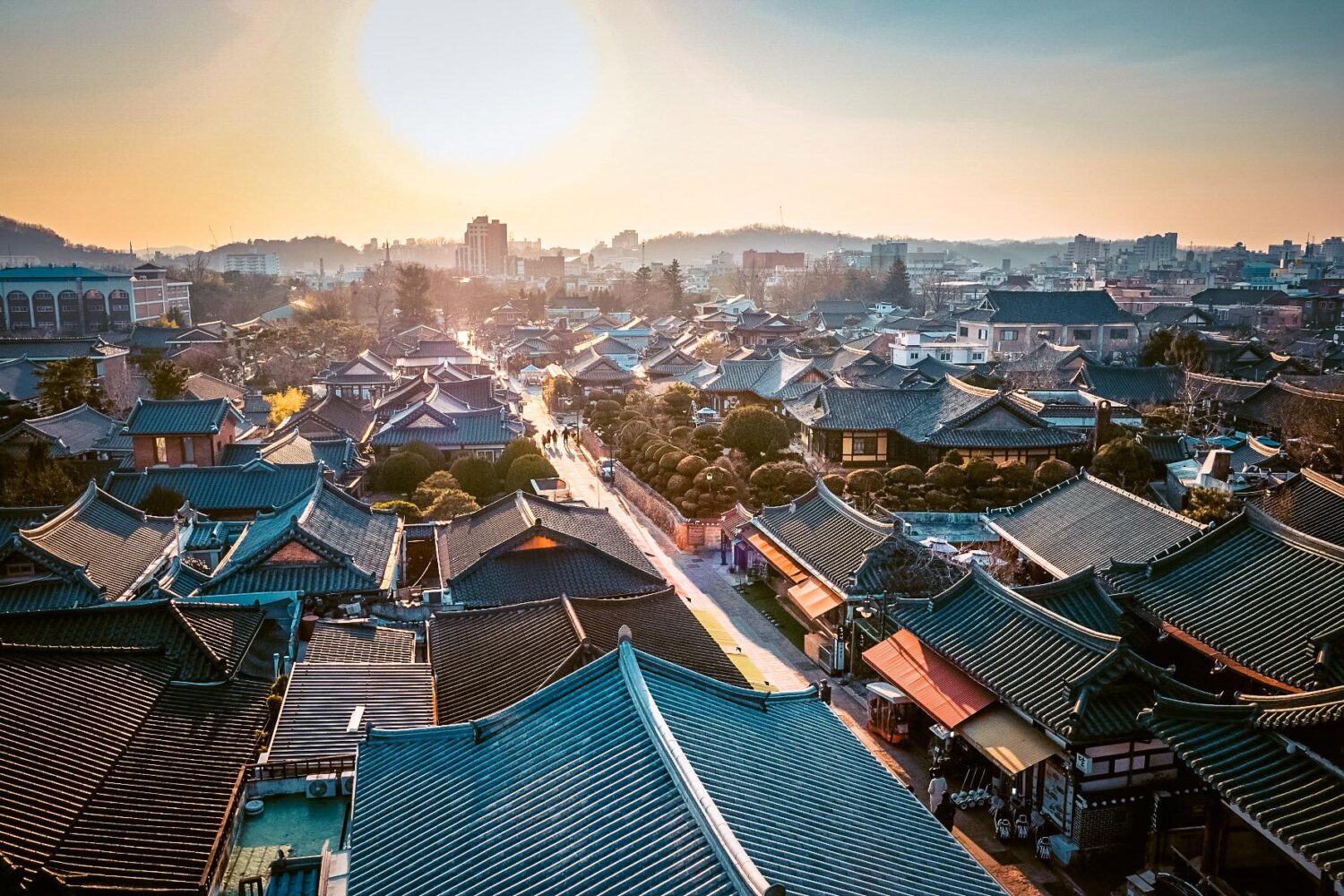
There are 800 traditional buildings in Jeonju Hanok Village
Tours that start in Busan, also add a visit to the Gurye Sansuyu Festival. If I had the choice, I’d probably take the tour from Busan.
It’s a shorter drive to Gwangyang (3 hours vs 5 hours from Seoul), and the Sansuyu Festival, which is located in Gurye, is ALSO difficult to get to using public transit.
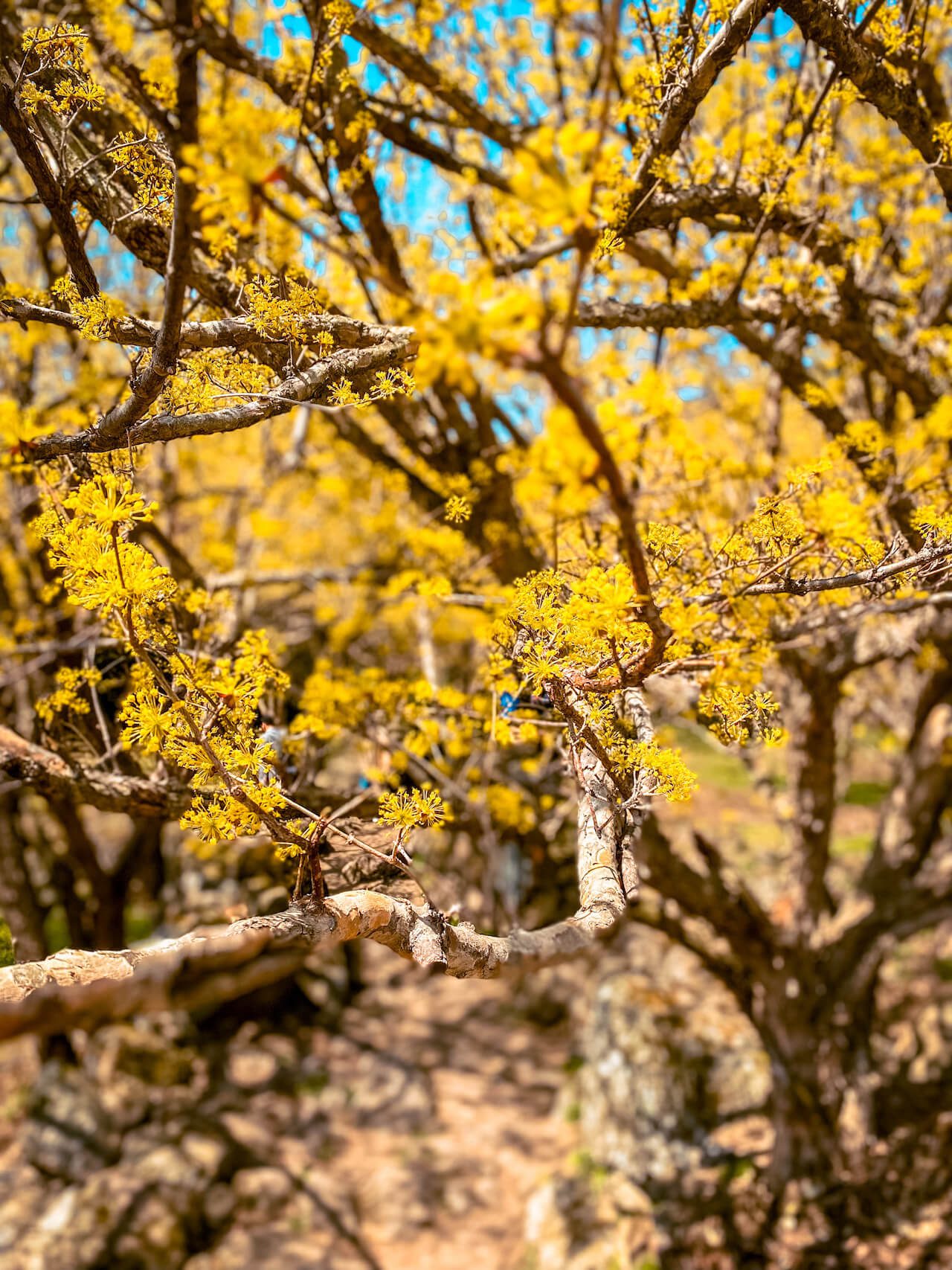
Sansuyu is another one of Korea’s first spring flowers.
TRAVELING WITH A GROUP? | Green tea fields, maehwa, sansuyu, and cherry blossoms, Jeollanam-do has it all! It’s the most gorgeous place in Korea in spring. See it all on your own private tour of the region. Check full details here.
From Seoul to Gwangyang DIY
If you don’t have your own transport, the next best option (if you don’t want to join a tour to the Gwangyang Maehwa Festival) is renting a car.
It’s actually really easy to drive outside of major cities like Seoul and Busan, and having a car would give you total flexibility to explore other spring sights in the Jeollanam-do region (of which, there are many!)
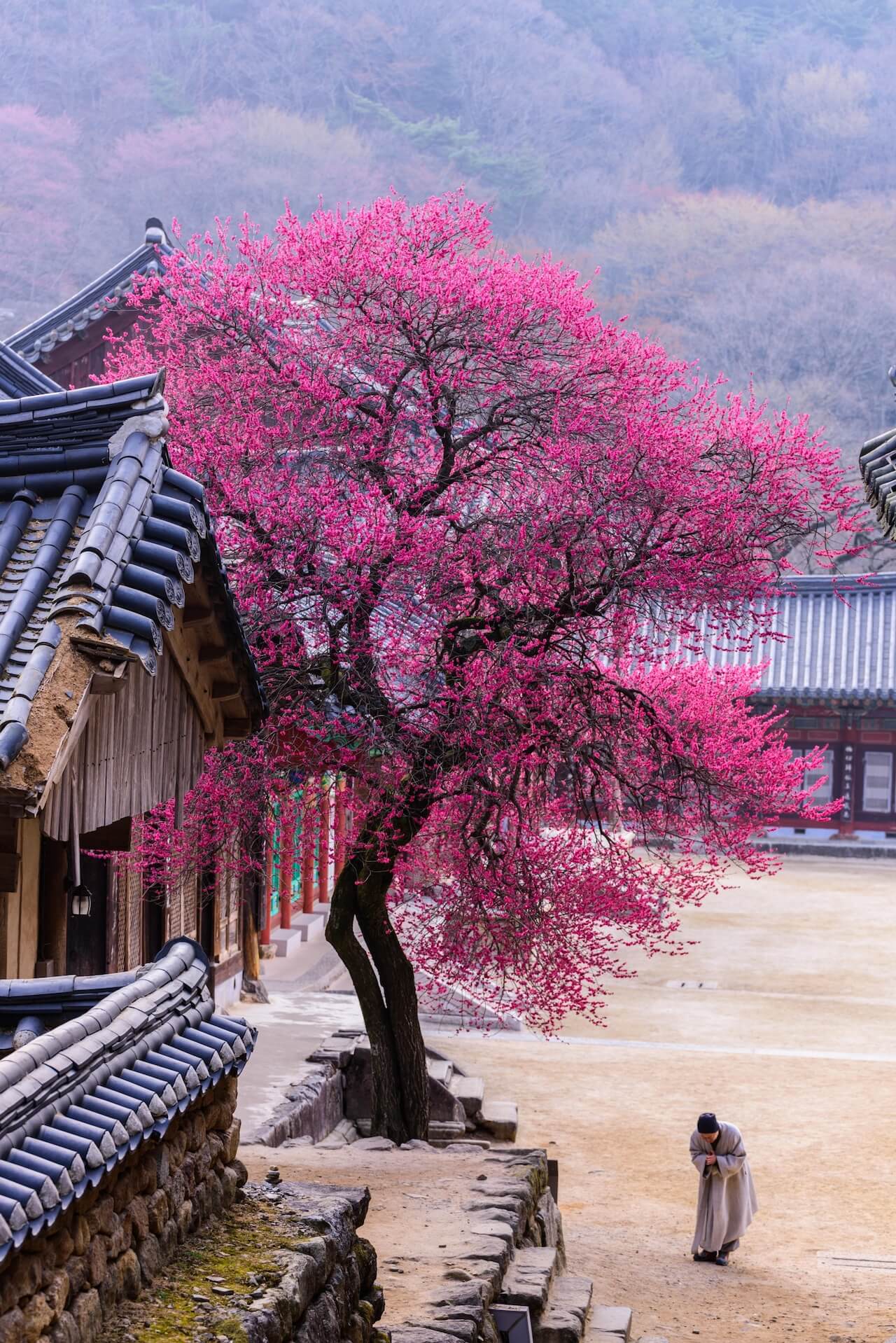
The red plum blossoms at Hwaeomsa in Jeollanam-do are a Korean Natural Monument © Lee Yong-jae, Korea Tourism Organization
Gwangyang Maehwa Village is around 340-km south of Seoul. With perfect traffic conditions, it takes about 4.5 hours to drive there.
Just make sure you pick up an IDP (International Drivers Permit) in your home country, before arriving in Korea. You won’t be able to rent a car without one.
Express or Intercity Bus to Gwangyang
There are several different buses, from multiple bus terminals making the trip from Seoul to Gwangyang. I researched these routes for this guide, but it’s still vitally important that you check them yourself on Naver or Kakao Maps, on your day of travel.
Routes and information can change based on your origin point, day of the week, and time of travel.
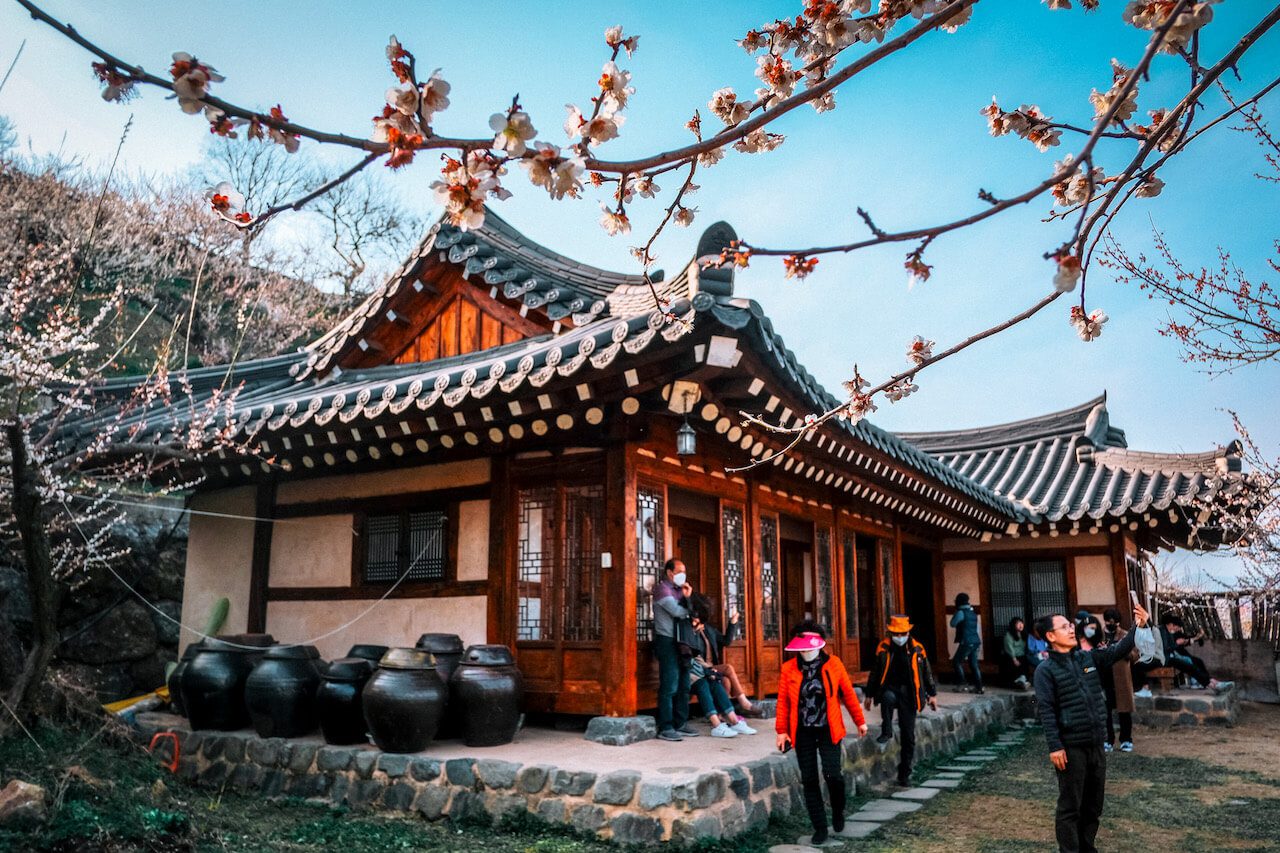
A hanok cafe and plum blossoms at Gwangyang Maehwa Village.
The total estimated travel time down to Gwangyang was pretty much the same for both of the following routes – about 5.5 hours.
- Intercity Bus from Nambu Bus Terminal to Hadong Bus Terminal (27,500). Walk 14 minutes to Hasan Village bus stop, then jump on local bus #35-1 to Seomjin bus stop. Walk 200-metres to the Gwangyang Maehwa Festival.
- Express Bus from Central City Bus Terminal to Jungma Bus Terminal (45,100 won). Transfer to Local Bus #15, and ride 33 stops to Seomjin bus stop. Walk 200-metres to Gwangyang Maehwa Village.
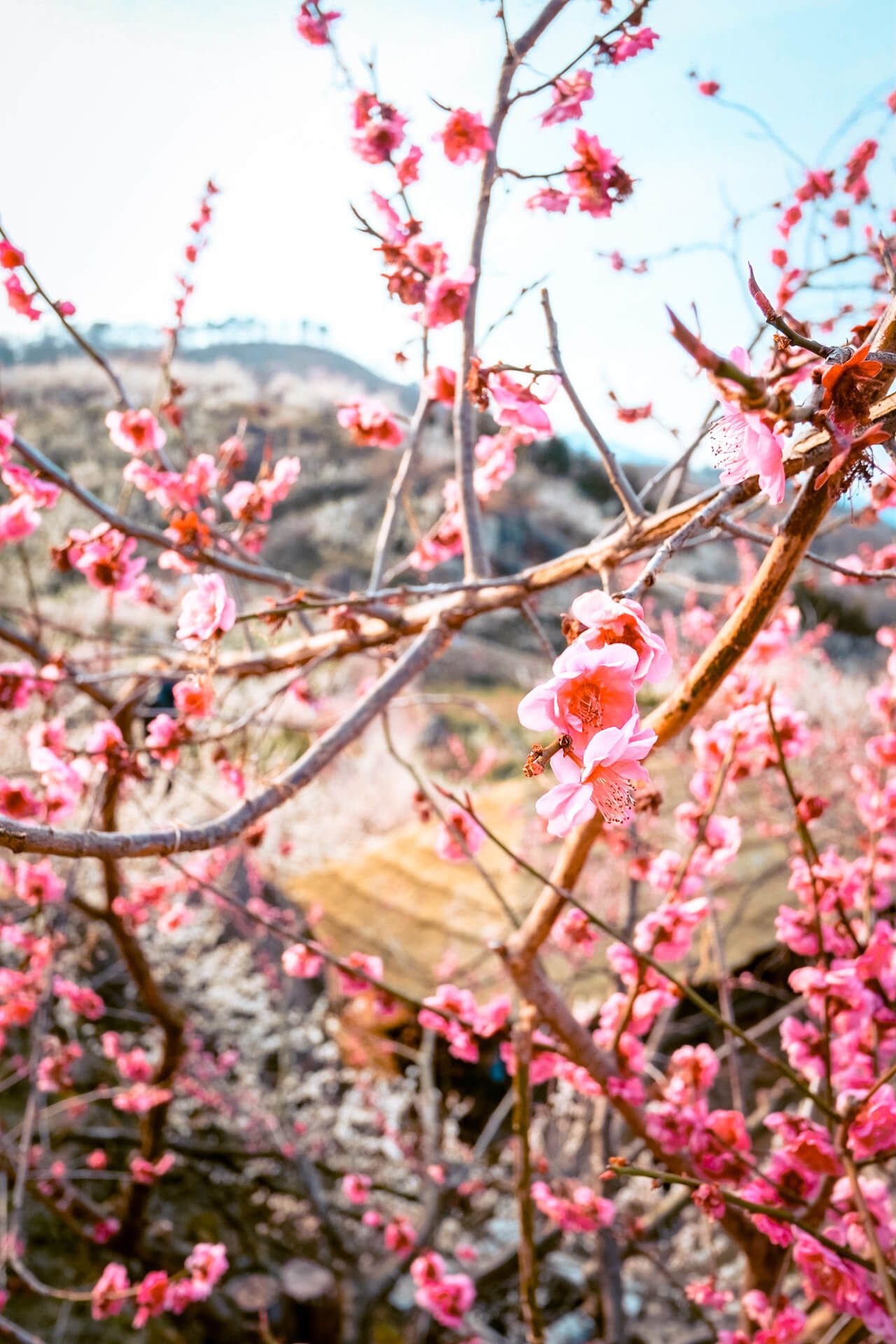
There are white, pink, and red plum blossoms at Gwangyang Maehwa Village.
The cost for long distance buses in Korea vary based on the company and quality of the bus. The prices listed above were pulled off Naver Maps, so could be different when you purchase.
Keep in mind also, that these travel times are based on catching the local bus right away, and this isn’t actually a realistic expectation. Rural buses are infrequent, or top out at 3x per day. You’ll likely wind up taking a taxi at some point in your journey to the Gwangyang Maehwa Festival.
KTX / Korail Train to Gwangyang
There is a train option for getting to Gwangyang, but it’s honestly so expensive and time-consuming compared to the other options, there’s almost no point in writing about it.
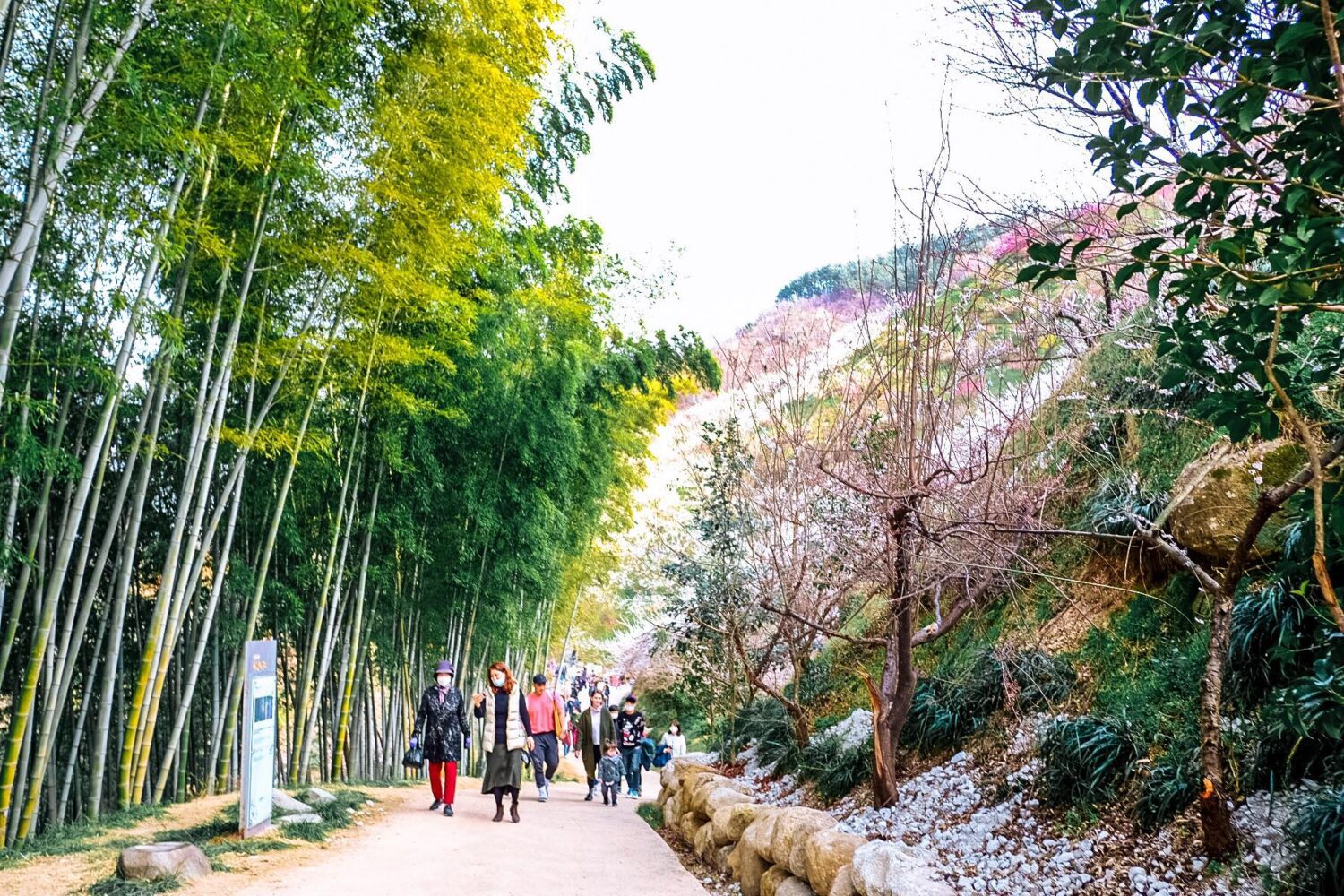
800 year old bamboo forest and plum blossoms at Gwangyang Maehwa Village.
However! If you’re staying in Myeongdong, and have the time, budget, and inclination – here’s what to do:
- From Yongsan Station, take a KTX train to Suncheon Station (2.5 hours, 44,000 won).
- From Suncheon Station, you have 3 options.
- Hop on a Mugunghwa train to Jinsang Station (20 minutes), walk to Port Mullyugo bus stop, and take local bus #15 to Seomjin (13 stops), then walk 200-metres to Gwangyang Maehwa Village OR…
- Take 3 separate local buses to get to Seomjin Bus Stop OR…
- Jump in a taxi directly to the festival site (50,000 won).
So yeah, there’s a real reason why I strongly recommend joining a tour to see the Gwangyang Maehwa Festival 😉
Limited Edition Spring Tours in Korea
When plum blossoms in Gwangyang Maehwa Village and Sansuyu in Gurye burst into bloom in mid-March, other spring flowers are not far behind. Like cherry blossom season, the dates for most of these tours is incredibly limited. Join them while you can!
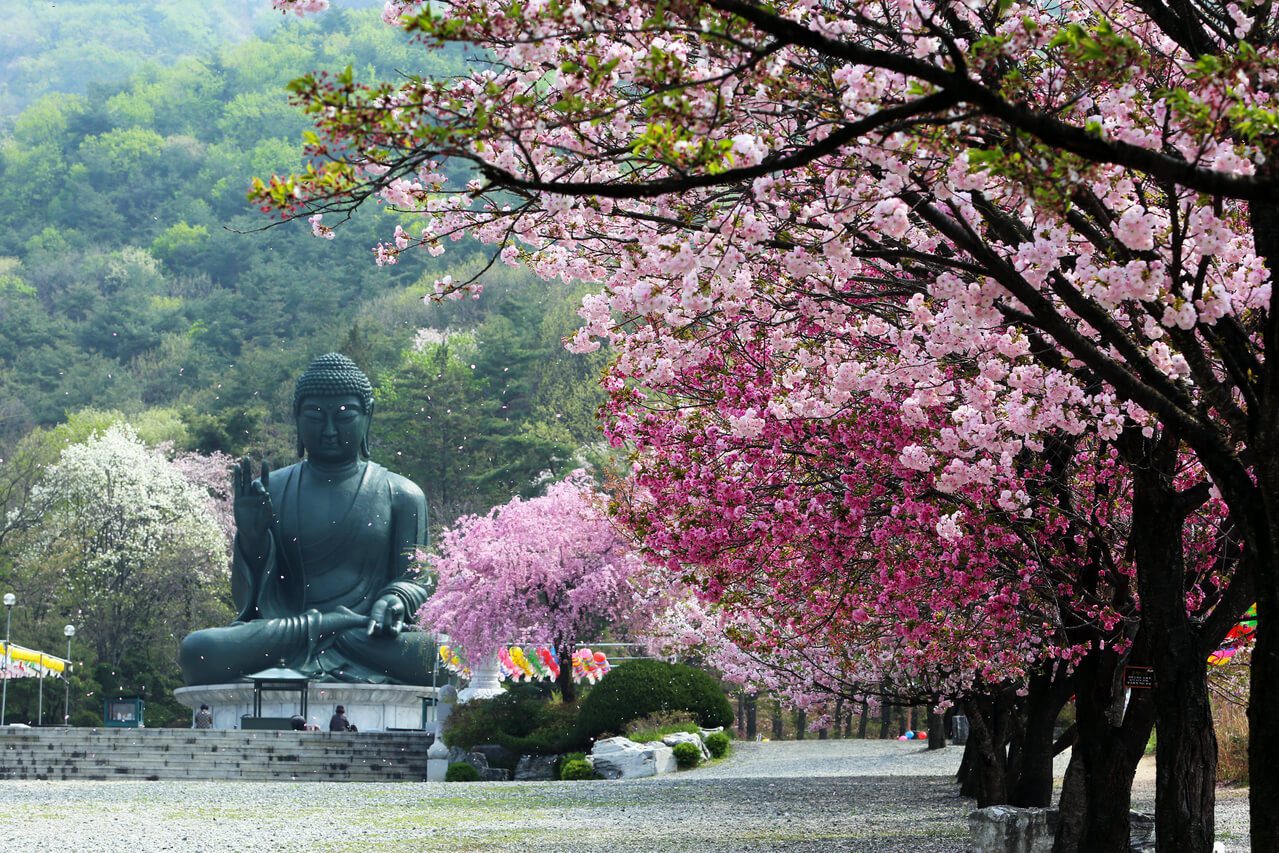
King cherry blossoms bloom in late April © Jin Jae-won, Korea Tourism Organization
- Gwangyang Maehwa & Jeonju Hanok Village Tour | March 10th – 21st, 2025
- Spring Flowers + King Cherry Blossoms at Hwaseong Fortress | March 18th – April 24th, 2025
- Jeonju Hanok Village + Spring Flower Festivals | March 18th – April 25th, 2025
- Seoul Seasonal Hot Attractions Tour | March 18th – May 13th, 2025
- Jeju Island Package: Flight, Private Tour + Hotel Option | March 20th – April 10th, 2025
- Jeju Island Cherry Blossoms and Canola Private Taxi or Van Tour | March 20th – April 10th, 2025
- Jinhae Cherry Blossom Festival Tour from Seoul or Busan | March 22nd – April 6th, 2025
- Haeundae Sky Capsule + Cherry Blossom Hunting in Busan | March 25th – April 7th, 2025
- Gyeongju Cherry Blossom Tour from Busan | March 28th – April 7th, 2025
- Chasing Cherry Blossoms in Seoul | April 2nd – April 13th, 2025
- Taean Tulip Festival + Strawberry Picking Experience | April 11th – May 4th, 2025
- King Cherry Blossom Tour from Seoul | April 14th – 24th, 2025
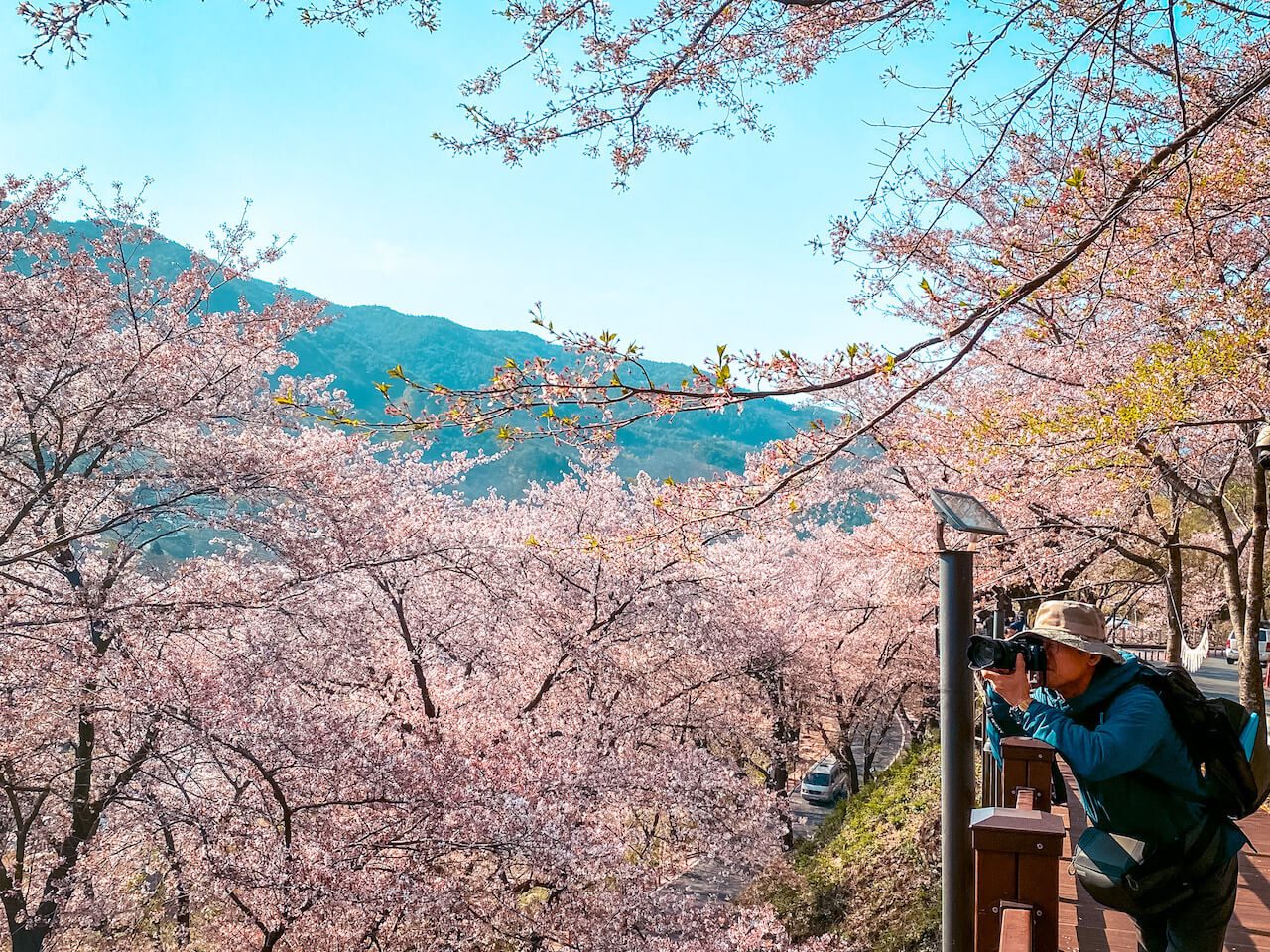
The cherry blossoms in Hadong are unbelieveable!
Where to Stay in Gwangyang
While Gwangyang Maehwa Village is technically in Jeollanam-do Province, it’s also very close to Hadong on the Gyeongsangnam-do side of the border, so you could search for places to stay in both places.
Whether you stay in Gwangyang or Hadong, count on at least 30 minutes via taxi to get to the Gwangyang Plum Blossom Festival site (since public transit is pretty much impossible.)
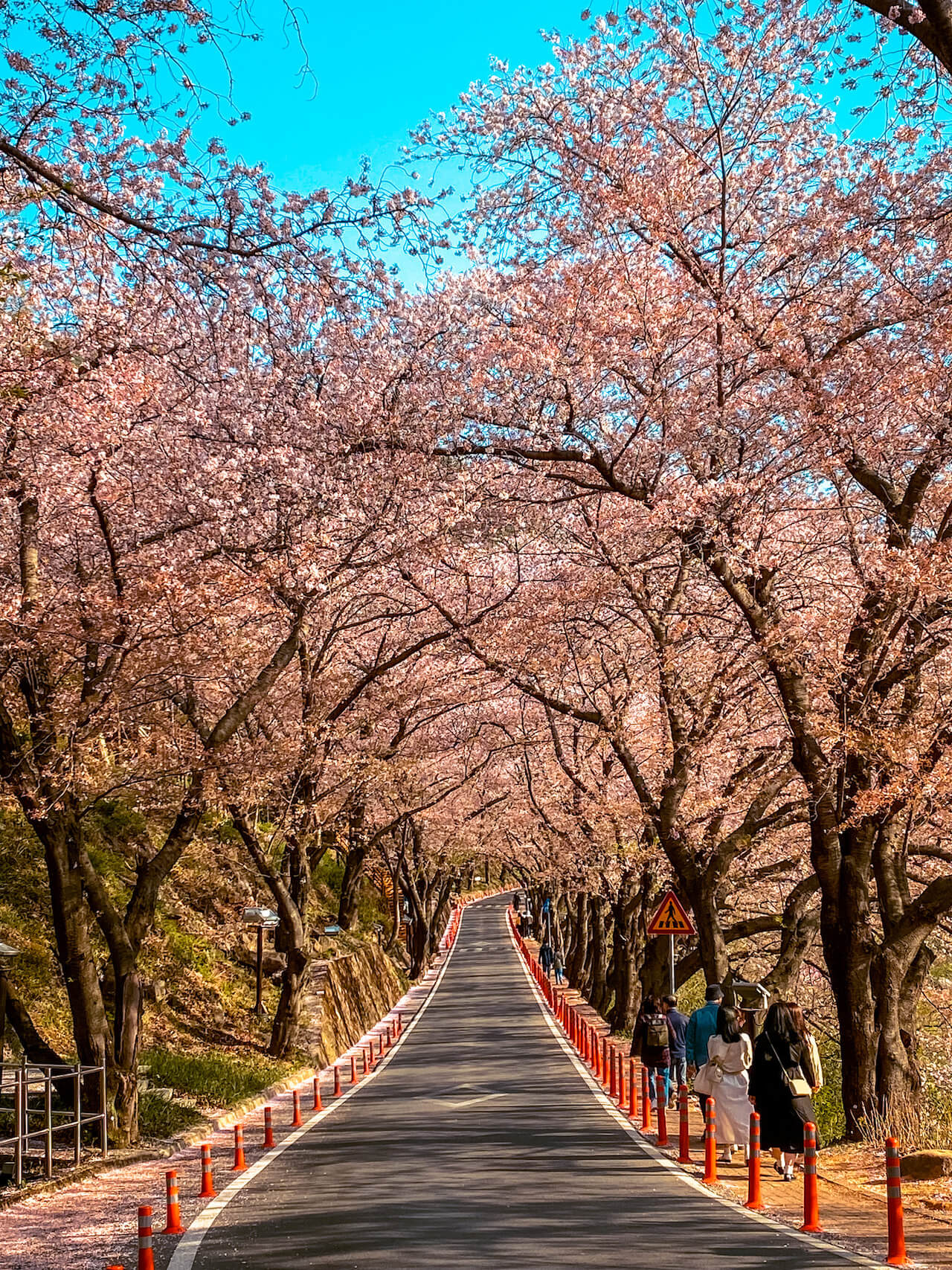
Hadong has some of the most gorgeous cherry blossoms in Korea.
If you do plan on getting to the festival DIY, an overnight stay is pretty much required. Not a bad thing though, because this province is totally worth exploring. There are so many beautiful things to see and do there!
This is my favourite part of Korea to visit in spring by far. I’ve spent several of the last few years, exploring Gwangyang, Gurye, Suncheon, Yeosu (and Hadong), and loved every minute of it. I can’t wait to go back for more!
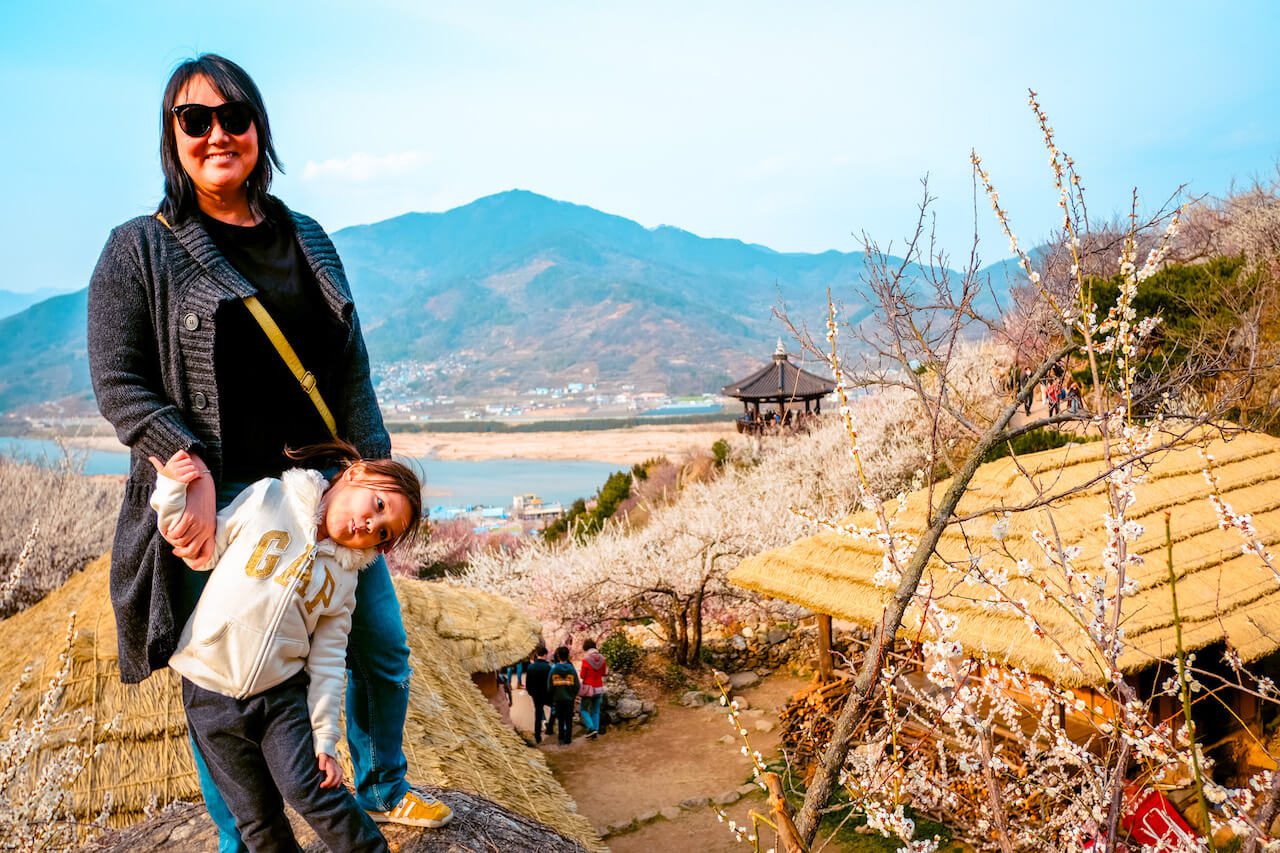
I’ve spent several spring seasons exploring the Jeollanam-do region.
I stayed at the Hotel Nol in Gwangyang. It’s not luxurious, but excellently priced, comfortable, super clean, and has everything you need.
If you plan to stay there, know that they only seem to release a month’s worth of hotel rooms on Booking or Agoda at a time, so you’ll have to keep checking back to reserve.
What to Eat at the Gwangyang Maehwa Festival
Cheongmaesil Farm is the biggest plum plantation in Korea, producing a huge number of maesil products.
That means that there are several special plum-based treats to try at the Gwangyang Maehwa Festival, including maesil ice cream, alcohol, juices, teas, and much more!
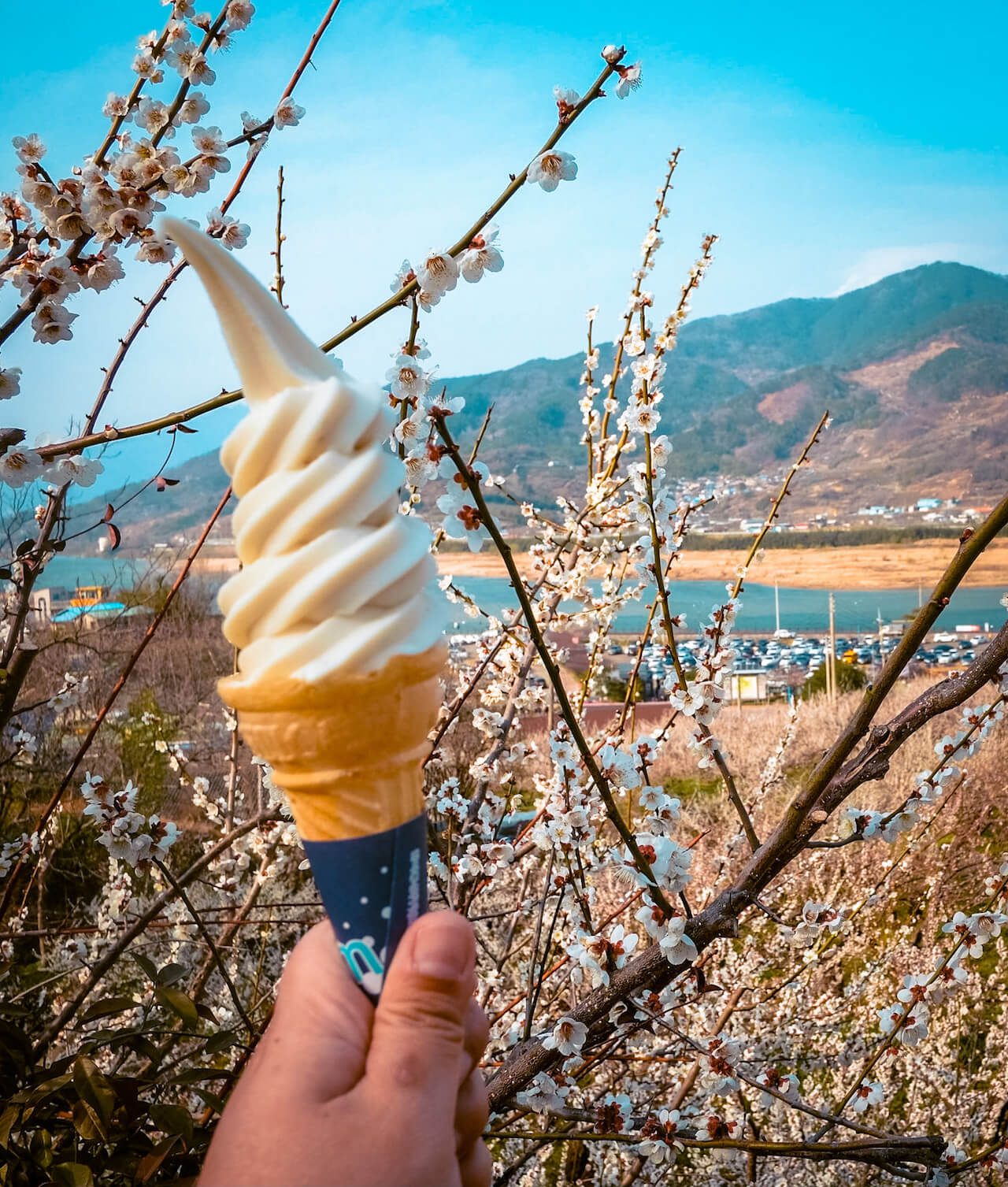
Maesil ice cream is a must-try at Gwangyang Maehwa Village.
There are also restaurants and cafes within the Village, and in the surrounding area, where you can try dishes incorporating all those plums. Try maesil bibimbap, maesil magkeolli, and a variety of other delicious Korean delights while at the Gwangyang Maehwa Festival.
If you do venture into the town, look out for Gwangyang bulgogi. With a more subtle flavour, it’s a specialty of the area. I have it every single time I visit Gwangyang.

Gwangyang bulgogi is served with a mountain of banchan.
Did this article help you? Writers (and moms especially) need caffeine!
Help support my small business with a cup of coffee.
Gwangyang Maehwa Festival: FAQs
Are you ready to experience a plum blossom paradise in Gwangyang?


